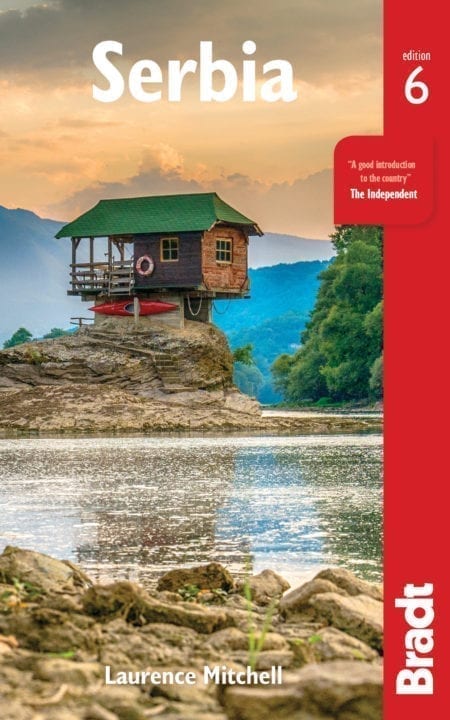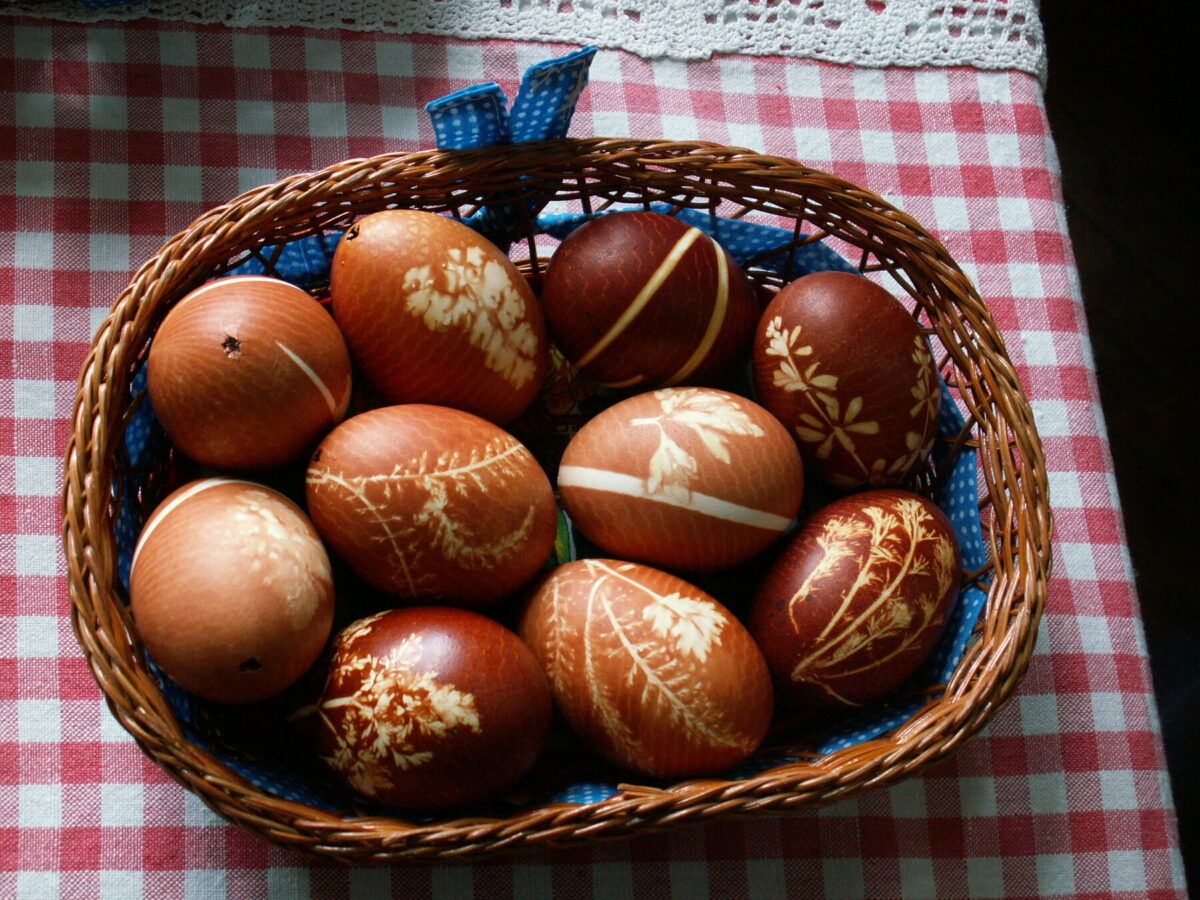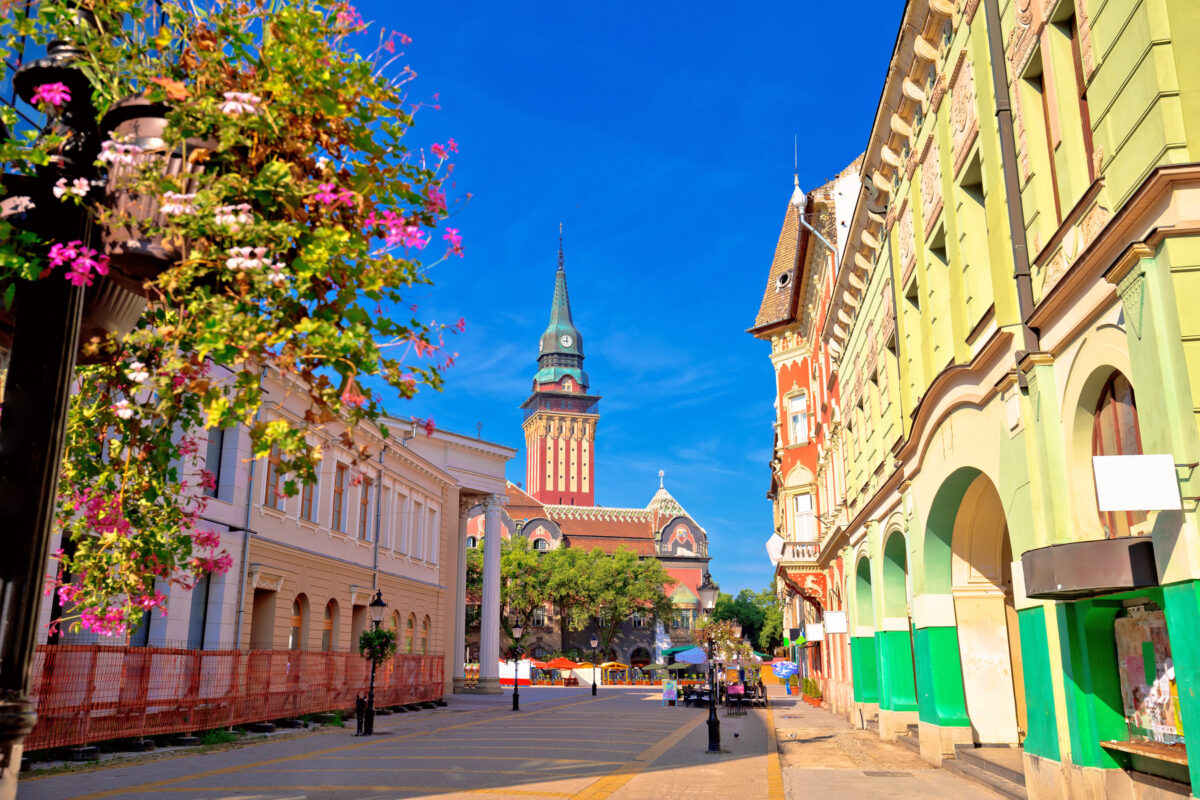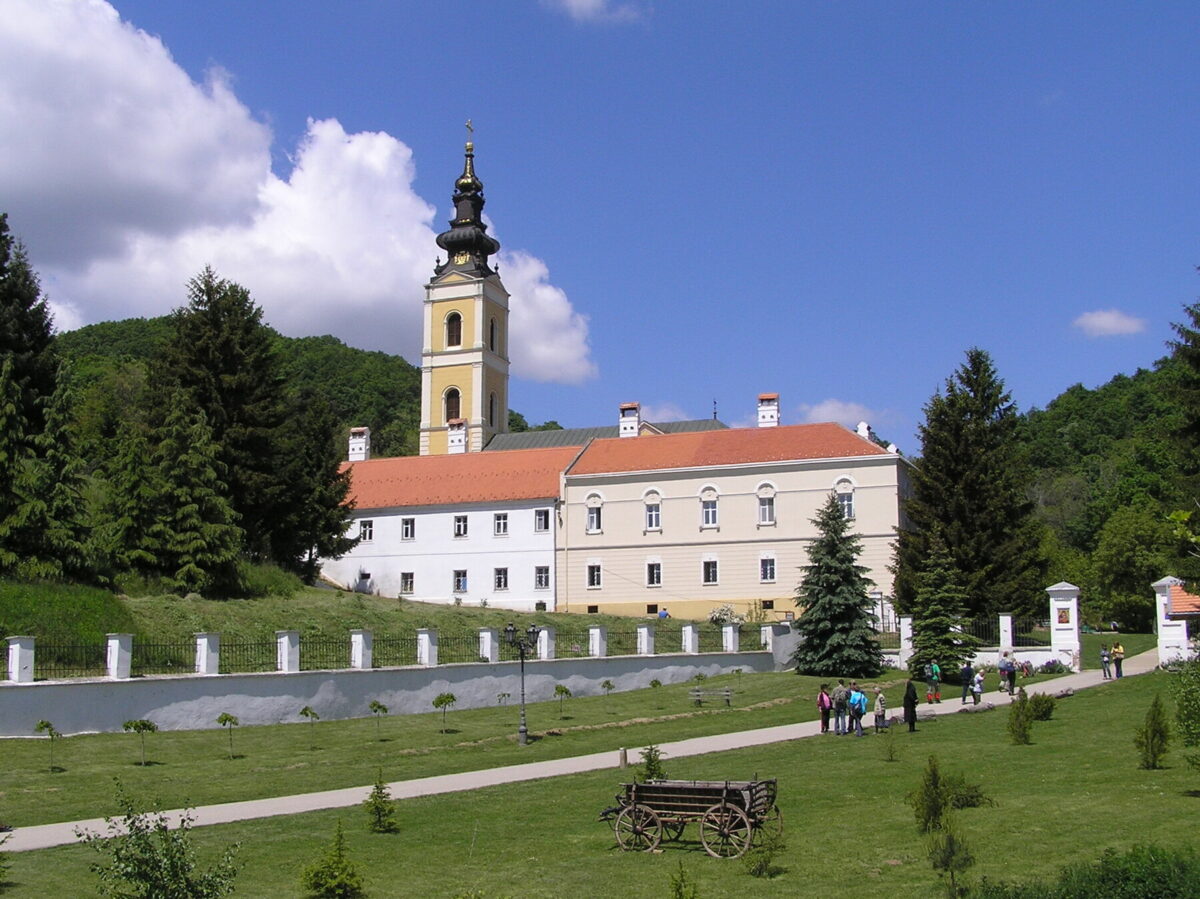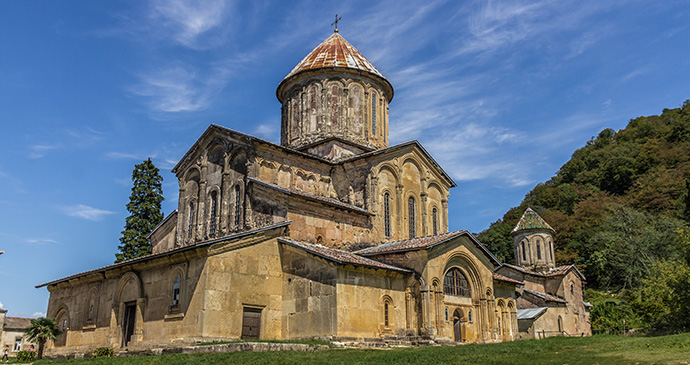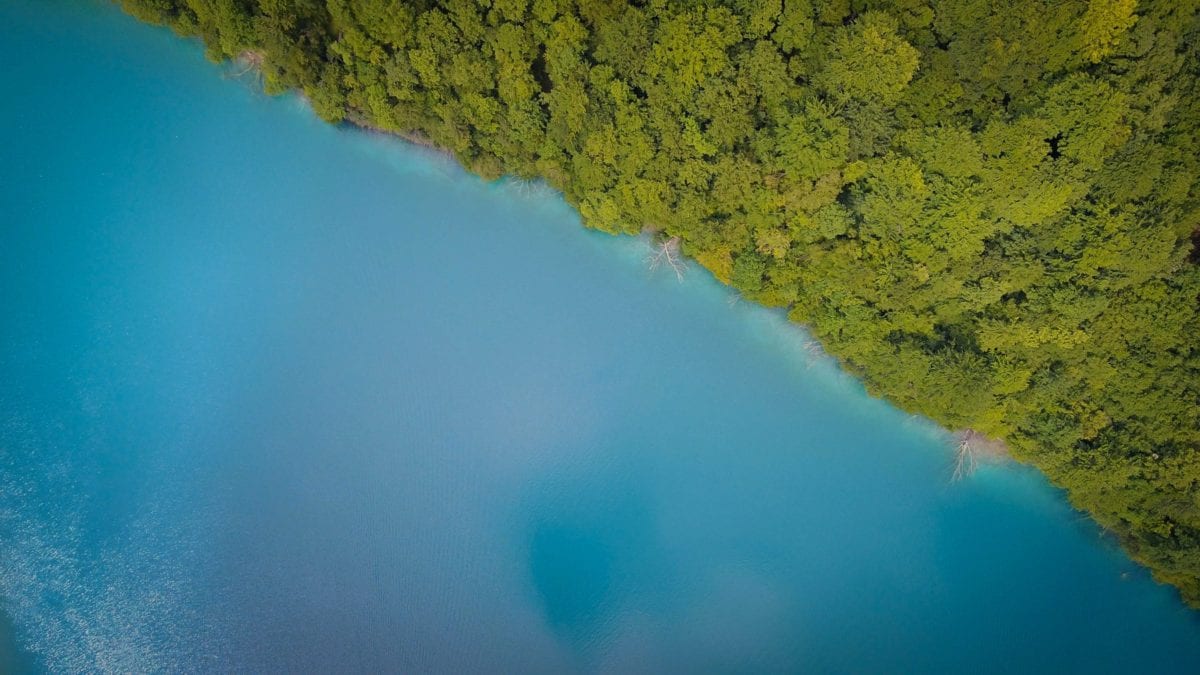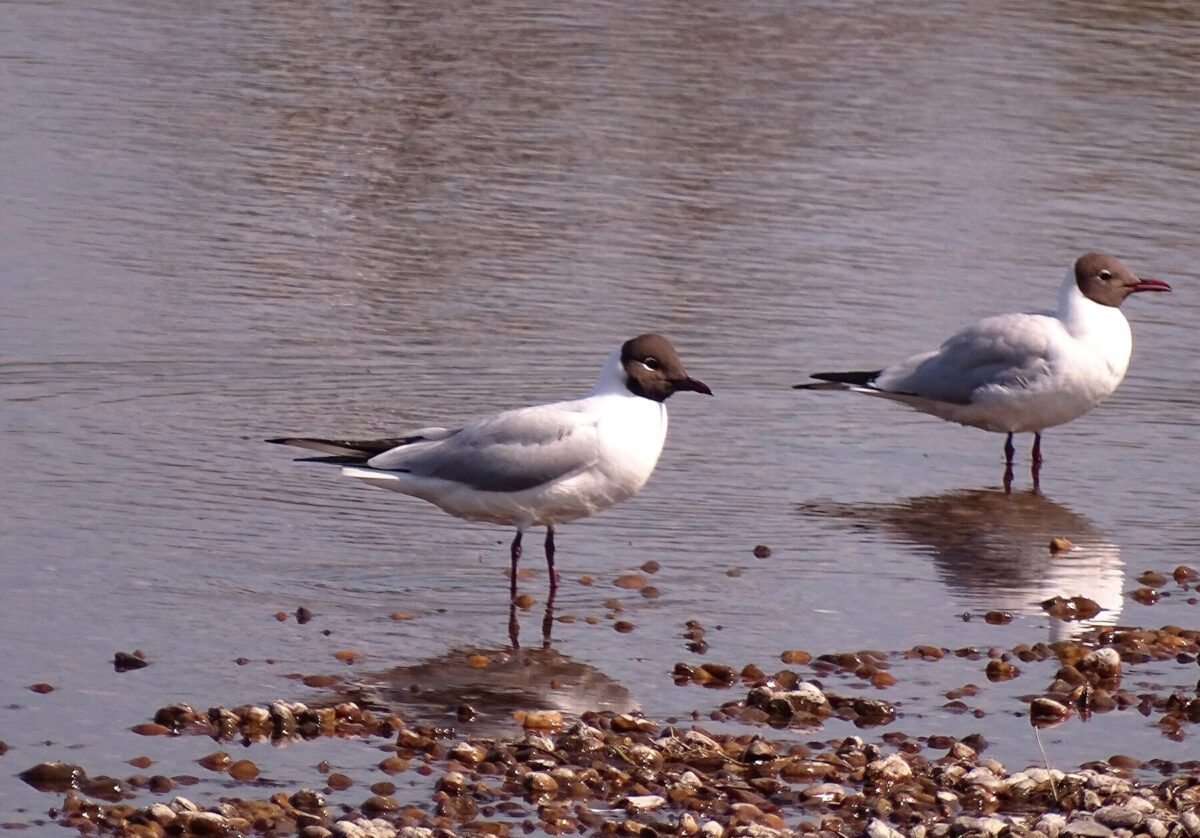Serbian culture is rich and varied: a unique hybrid that is westward-looking but with echoes of an Ottoman past.
Laurence Mitchell author of Serbia: The Bradt Guide
With a long and colourful history that stretches back as far as the early medieval period, and indeed to the Roman occupation long before that, Serbian culture is rich and varied: a unique hybrid that is westward-looking but with echoes of an Ottoman past.
The long period of Turkish rule has left its mark on the food, music and language of the country, as have influences from Austria and Hungary to the north. While a Habsburg city like Novi Sad, a place resolutely part of the central European milieu, lies just an hour’s drive north of Belgrade, travelling to the south of the country brings the visitor to very different places like Novi Pazar, where the Turkish influence remains strong and the skyline bristles with minarets.
Belgrade itself, the largest city in the region, may not be the most elegant of capitals, but it has a vitality undiminished by its years of isolation. These days, it is a vibrant, sophisticated city where tradition and modernity comfortably coexist – a dynamic capital with museums, galleries and nightlife equal to anywhere in the region. Smaller university cities like Novi Sad and Niš have their own individual appeal too, as do many of Serbia’s smaller country towns.
In a landscape punctuated by river valleys, gorges and rolling hills, nature lovers are well provided for. National parks such as Mount Tara in the west, Fruška Gora in the north and Đerdap Gorge in the east are ideally situated for outdoor activities such as hiking, cycling and birdwatching, while Zlatibor and the southern mountain resort of Kopaonik offer winter skiing.
Thankfully, Serbia’s bad-boy image and demonised reputation are now seen as a thing of the past. Even a casual observation reveals a country keen to take its rightful place in wider European society. In 2011, following the country’s placement on the White Schengen List, Serbians were finally allowed visa-free travel inside the EU bloc. For the first time in decades – since they were all ‘Yugoslavs’ in fact – Serbians were able to freely travel to the countries that surrounded them. The year 2012 brought further progress when the country was awarded full EU candidate status. As things stand, the country is expected to complete negotiations by 2024 and join the EU by 2025.
It cannot be denied that things are definitely looking up for Serbia these days, so don’t delay: get there as soon as you can.
For more information, check out our guide to Serbia
Food and drink in Serbia
Food
Serbian cuisine is similar to that of other Balkan countries, with a few specialities that it can claim for its own. The long Ottoman occupation clearly had some influence, especially in the wide range of grilled meats available. In fact, Serbs enjoy eating meat in as many ways as they can think of cooking it. This passion for animal flesh is reflected in a cuisine that, while both tasty and wholesome, can be daunting for vegetarians and health-food aficionados.
Although there are hints of the Mediterranean in the cooking, most Serbian food is on the heavy side with a tendency towards greasiness. This is not the whole picture, of course. While meat is enjoyed in quantity at every possible opportunity, so are fresh vegetables, and, in a country where fresh, unadulterated produce is still a fact of life – fertilisers and pesticides are rarely used – it is possible, with a little careful selection, to eat well whatever one’s personal dietary tastes might be.
If you are vegetarian then you will need to declare, ‘Ja sam vegetarijanac’ if you are a man, or ‘Ja sam vegetarijanka’ if female. It’s probably better to be more specific and say, ‘Ne jedem meso’ – ‘I don’t eat meat’ – perhaps adding, ‘Ne jedem pileće meso, ribu ni šunku’ – ‘I don’t eat chicken, fish or ham’ – just to be on the safe side.
The problem with eating out in Serbia is often a matter of understanding exactly what is on offer, as menus are often written in Cyrillic and hard to decipher. There is also the phenomenon of overly optimistic menu-writing in which the items listed merely reflect the chef ’s familiarity with sophisticated cuisine rather than his ability or willingness to produce it.
A typical meal might consist of kajmak – a sort of salty, cream-cheese spread of Turkish origin – with bread to start, then a grilled meat like ćevapčići with a salad. Fresh fruit is as likely to conclude a meal as any sweet dish. While wine is often chosen to accompany a meal, something stronger like a glass or two of šljivovica might well precede it as a high-octane aperitif.
For starter courses, smoked meats are a popular choice, with dalmatinski pršut, a lightly smoked ham, or užički pršut, a hard, smoked beef, frequently offered on menus. Another meat preserve, pihtije, a dish of jellied pork or duck with garlic, tastes much better than you might imagine. A dip that can be spread on bread in the same way as kajmak is ajvar, slow-cooked peppers, which are chopped and seasoned with vinegar, oil and garlic. Although there are proprietary brands of ajvar available, the very best is that which is produced in thousands of rural Serbian kitchens each autumn at the end of the pepper season.
Drink
Traditionally coffee means strong and thick Turkish coffee (turska kafa). Sugar is added at the beginning of the brew and so it is customary to specify the amount of sweetening that you require. If you do not specify then it will invariably come medium sweet (srednje slatka), although with foreigners they quite often let you add your own to taste. The relative proximity to Italy has meant that most establishments now have espresso machines and so even a kafana in a small provincial town can usually conjure up a convincing espresso or cappuccino.
Tea (čaj) is also available but it is usually fairly weak and insipid. For tea with milk, ask for sa mlekom, with lemon, sa limunom. Speciality and herb teas are also popular and some city cafés have a good selection of these.
Most Serbian wines are drinkable and some are actually very good. The best are probably the white wines (belo vino) that come from the Sremski Karlovci region in Vojvodina, but Serbia has a range of wines that come from various grape-producing regions such as Vršac and Negotin. Some red wines (crno vino) also come from Montenegro. Wine can be bought in restaurants and cafés by the bottle, by the glass or in carafes of various sizes. In a supermarket, a bottle of decent domestic wine will cost something in the order of 250–700din; in a restaurant, maybe double this.
Serbians are proud of their wines but probably more enthusiastic about the range of alcoholic spirits they produce. Experimentation with these products can be something of an adventure. Šljivovica is a sort of brandy traditionally made from plums, but rakija, which is normally a spirit made from grapes, tends to be used as a generic term for any sort of strong liquor. Konjak is, as its name implies, cognac, and lozovača, another form of grape brandy. There are also annual rakija festivals in Pančevo and Belgrade. Attend them at your peril.
Health and safety in Serbia
Health
Medical treatment in Serbia is available free to UK residents on production of a UK passport. If you are a UK resident but not a UK national, you will need a certificate of insurance from HM Revenue and Customs Centre for non-residents. However, taking out health insurance is highly recommended. Hospital treatment, some dental and medical treatment should be free, but you will have to pay for prescribed medication.
With good insurance you may prefer to use a private clinic. Many doctors who work in private clinics will have been educated abroad and thus able to speak English – a great comfort in times of illness. Also, the standard of care in most private clinics is reasonably high. Some medications may not be as freely available as at home, so it is important that the visitor brings along a sufficient supply of any necessary medication that they are dependent upon.
On the whole, Serbia is a healthy place; the greatest health danger that visitors are likely to encounter is probably an unacceptable degree of passive smoking in public places. Most food in Serbia is hygienically prepared and meat is rarely served very rare, which minimises the risk of picking up parasites and developing intestinal complaints.
Tap water is generally perfectly safe for consumption. However, it is always best to drink bottled water if you can to avoid any unnecessary upset stomachs. Some of the homemade liquor that may be offered to the visitor in parts of rural Serbia should be treated with caution but to refuse it outright might appear rude.
Vaccinations
The following immunisations are recommended, depending on the nature of a visit. In all cases, these are of low to moderate risk and some really only apply to extended visits to more remote areas of the country. If you are planning an extended stay, it is wise to visit your doctor or a reputable travel clinic at least four weeks before travel.
Routinely you should be up to date with tetanus, diphtheria and polio, which is now given as an all-in-one vaccine (Revaxis) that lasts for ten years. You would also be advised to ensure that you are vaccinated against measles-mumps and rubella (MMR). Two doses of vaccine are recommended, given at least one month apart.
Other vaccines that may be recommended depending on the length and nature of your trip are hepatitis A, rabies, tick-borne encephalitis and hepatitis B. The latter three vaccines are composed of three doses, so ensure that you leave plenty of time.
Safety
Serbia’s oft-perceived image as a lawless, rather dangerous sort of place is far from the truth. The reality is in fact very different and visitors have nothing to fear. Even Belgrade feels very safe indeed when compared with London, Paris or New York. In fact, it seems the sort of city where anyone – young or old, male or female – can walk around safely at any time of day or night. The British disease of aggressive binge drinking does not appear to exist here; instead, the streets are calm and civilised, even late at night, with well-behaved young people crowding the pavements or drinking coffee at outdoor tables.
If this all sounds too good to be true, the statistics bear it out: robbery and violent crime are rare, which is not to say that visitors should be complacent as opportunist thieves exist everywhere, and perhaps should be expected in a country that has suffered continual economic hardship for such a long period. As in any city, you should avoid seemingly deserted streets and parks late at night. As long as you keep away from large public demonstrations, and avoid the few unfortunate areas where there are obvious ethnic tensions, Serbia is very safe indeed.
Female travellers
Although domestic violence against women is sadly a reality in some parts of Serbia, foreign women undergo no particular risks in visiting the country – the majority of Serbian men are courteous in the extreme. Sexual harassment is not completely unknown but it is by no means commonplace. It is probably true to state that women visitors are at a lower risk of sexual assault or rape here than they are back home in northern Europe.
LGBTQ+ travellers
Homosexuality is legal (and tolerated) in Serbia, although same-sex marriages are banned. However, open displays of same-sex affection could well provoke a hostile reaction, and many Serbian men, especially young macho ones, have a rather unenlightened view of homosexuals, in particular, gay men. The situation is slowly improving but it is wise to remember that there have been numerous cases of openly gay men being attacked in the street, especially late at night while leaving clubs.
The caveat of no ‘open displays of affection between same-sex couples’ is a sensible one as emotions seem to run high when those more conservative members of Serbian society are confronted with a sexuality that differs from their own. A useful website for LGBTQ+ travellers to consult before heading to Serbia is gay-serbia.com.
Travel and visas in Serbia
Visas
Nationals from UN member states that do not have diplomatic relations require visas to enter Serbia; however, most foreign visitors do not require visas for a short stay in the country. Passport-holders of the following countries may stay in Serbia for a period up to 90 days without the requirement of a visa: Albania, Andorra, Argentina, Armenia, Australia, Austria, Azerbaijan, Belgium, Bolivia, Bosnia and Herzegovina, Bulgaria, Canada, Chile, Costa Rica, Croatia, Cuba, Cyprus, Czech Republic, Denmark, Estonia, Finland, France, Georgia, Germany, Greece, Hungary, Iceland, Ireland, Israel, Italy, Japan, Kyrgyzstan, Latvia, Liechtenstein, Lithuania, Luxembourg, Malta, Mexico, Monaco, Mongolia, Netherlands, New Zealand, North Macedonia, Norway, Peru, Poland, Portugal, San Marino, Seychelles, Singapore, Slovakia, Slovenia, South Korea, Spain, Sweden, Switzerland, Tunisia, Turkey, United Kingdom, United States of America and Vatican City.
For those requiring a visa, an application should be made at one of Serbia’s foreign embassies where the applicant will be required to produce a valid passport, a letter of introduction (this can be organised through a Serbian tourist agency or a business contact), a return ticket, proof of funds and evidence of medical cover for the duration of the stay.
Funds in excess of €5,000 should be declared on arrival in the country as, in theory at least, failure to do this could result in confiscation on leaving Serbia.
Getting there and away
By air
A number of airlines serve Belgrade directly. At Belgrade’s Nikola Tesla Airport, Terminal 2 deals with all international traffic. Note that the airport charges all adult passengers a departure tax of €16.50 for international flights, although this should be included in the ticket price.
There are daily direct flights to Belgrade from Heathrow every day with Air Serbia, with flights that leave Heathrow in the early afternoon to conveniently arrive in Belgrade by late afternoon. The return flight leaves mid morning to arrive at Heathrow around midday. The price is in the order of £150—220 return including tax, although it may be difficult to get this price during busy holiday periods or at short notice.
The other direct alternative from the UK is to fly to Belgrade with Wizz Air from London Luton, which has return flights as low as £80 (extra for baggage) if booked well in advance. Services leave Luton very early in the morning three to four times a week, and the return leg leaves Belgrade mid morning to arrive in Luton early afternoon. An indirect option that might save a little money is to combine a cheap budget airline flight with a train or bus journey through to Serbia, for example, by taking a cut-price Ryanair flight to Budapest in Hungary, and then continuing the journey by bus.
By bus
There are direct bus routes to Serbia from all over western and northern Europe. For the longer journeys, given the cost, time and discomfort involved, flying is probably a more attractive option.
Eurolines, which in Serbia is operated by the Lasta bus company, run services between Serbia and Austria, Bosnia and Herzegovina (and Republika Srpska), Croatia, Czech Republic, Denmark, France, Germany, Italy, the Netherlands, Montenegro, North Macedonia, Slovakia, Slovenia, Sweden and Switzerland. Another company, Srbija Tours International, operates services to various destinations in Germany and Italy. For other international services that operate from Belgrade bus station contact BAS Turist.
By car
With Serbia’s landlocked position, surrounded by a total of eight other countries, it is little surprise that there are many options available if you are driving your own vehicle. From Hungary, there are crossing points at Bački Beg, Bajmok, Đala, Horgoš and Kelebija, and from Romania at Đerdap, Kaluđerovo, Srpska Crnja and Vatin. From Bulgaria, crossings exist at Gradina, Mokranje, Ribarci, Strezimirovci and Vrška Čuka, and from North Macedonia at Globočica, Preševo and Prohor Pčinjski.
Croatian border crossings are at Bačka Palanka, Batrovci, Bezdan, Bogojevo, Ljuba, Neštin, Odžaci, Šid and Sot, while land crossings across to Bosnia and Herzegovina are at Badovinci, Bajina Bašta, Kotroman, Ljubovija, Loznica, Mali Zvornik, Sremska Rača, Trbušnica and Uvac. There are also border crossings between Albania and Kosovo at Čafa Prušit and Vrbinca and at Đeneral Janković between Kosovo and North Macedonia. All of the crossings listed are open around the clock.
Getting around
By bus
This is the most popular and practical means of getting around the country. There are services between most towns and, from Belgrade in particular, there are frequent departures to even the furthest-flung regions. Most towns of any size have a purpose-built bus station that will have left-luggage and snack facilities. Timetables of departures and arrivals are shown on large boards, usually in Cyrillic. Tickets can be bought in advance from booths inside the bus station and on some routes they can sell out quickly, particularly during public holidays
Many larger bus stations will sell you a peronska karta with your ticket – either a platform ticket or a token for a turnstile. This generally adds 50–100din to the total ticket price. It is also possible to buy a peronska karta only and then go through and choose your own bus, paying the driver or conductor. This will give you more flexibility on busy routes as, generally, the ticket counter will just sell you a ticket on the next bus available. Sometimes, particularly if the bus is due to leave, they just sell you a platform ticket anyway and let you sort it out on the bus.
By train
Trains are an alternative on some routes, although the Serbian railway network has deteriorated over the past two decades as a result of poor maintenance, lack of investment, management–trade union clashes and war damage. The ongoing, years-long closure of the line between Belgrade and Novi Sad for reconstruction has certainly not helped matters either.
In practical terms, trains are cheaper than the bus option, but they are usually slower and more prone to breakdown. For comparison, while there are about 20 buses a day between Belgrade and Niš that take around 3 hours, the eight trains that run between the two cities take between 4 hours and 5½ hours. Serbian trains do come into their own on some longer journeys, especially the wonderfully scenic route down to the Adriatic coast at Bar in Montenegro.
Overall, trains are a good way to travel if you are not in any great hurry. The common perception is that Serbian trains generally leave on time but arrive at their destinations late. Certainly, they are a good way to meet people, especially on longer trips. Information on train services can be gathered from the Serbian Railways website, or from individual railway stations.
By car
Hire cars are available in towns and cities throughout the country, although Belgrade and Novi Sad have the widest choice of agencies. Driving is reasonably straightforward, and takes place on the right – mostly. Most main roads are in reasonable condition, although minor roads in the countryside can be in quite poor repair with pot-holes and loose stones. Because of the preponderance of blind corners and the occasional speed-crazed local, driving at night in rural areas can sometimes prove to be a nerve-racking experience that is probably best avoided.
In order to drive in Serbia you must have an international driver’s licence and a Green Card (international insurance). The wearing of seat belts is compulsory and traffic police are keen to impose fines for failing to do this, as they are for any infringements of the speed limit.
When to visit Serbia
Climate
Serbia has a climate similar to the rest of southeast Europe, although it rarely gets as hot as Greece during the summer months or as cold as Romania in winter. Unless a skiing vacation is planned, winter is not a good time to visit: it will be cold and wet, perhaps snowing, and many of Serbia’s less expensive hotels have inadequate heating. The summer months are rarely oppressively hot, although it can become quite sticky in Belgrade during the dog days of August.
The average air temperature in Belgrade is 11.9°C. Autumn is longer than spring, often with extended periods of warm, sunny, anti-cyclonic weather; in contrast, spring is often short and rainy. Winter is not especially harsh by eastern European standards, with only an average of 21 days annually below 0°C. The average temperature in January is 0.4°C making it the coldest month of the year. Summers generally begin abruptly, with July and August being the hottest months overall, having average temperatures of 21.7°C and 21.3°C respectively. Like many other countries, however, Serbia has experienced greater extremes of temperature in recent years, with summer often exceeding 33–38°C for several days and winter temperatures sometimes as low as –12°C or even colder.
Festivals and public holidays
Depending on personal interests, it is a good idea to try and make your visit coincide with particular events that are taking place throughout the country, ie: for music fans this might be during the EXIT Festival (pop and rock) that is held in Novi Sad during July, the Dragačevo Trumpet Festival (Gypsy brass bands) that takes place at Guča in western Serbia every August, or the Belgrade Music Festival BEMUS (classical) that is hosted by the capital in October.
Alternatively, you may wish to time your visit to coincide with religious and cultural celebrations like Orthodox Easter, which can be an enjoyable time to visit. Overall, May, June and September are probably the most perfect months, although May and June are also marginally the wettest. In the countryside, early to mid-October can be a delight, still reasonably warm but with golden autumn colours, and this is a superb time for energetic outdoor activities like walking or cycling.
Hotel accommodation and public transport can be at a premium at certain times of year like Easter, New Year or during the EXIT festival in Novi Sad in July or the Belgrade Book Fair in October, but as a rule this presents few problems. The one thing that you can be certain of, for the time being at least, is that wherever you go and whenever you choose to visit Serbia, it is unlikely to be overrun with tourists. Enjoy this while it lasts.
What to see and do in Serbia
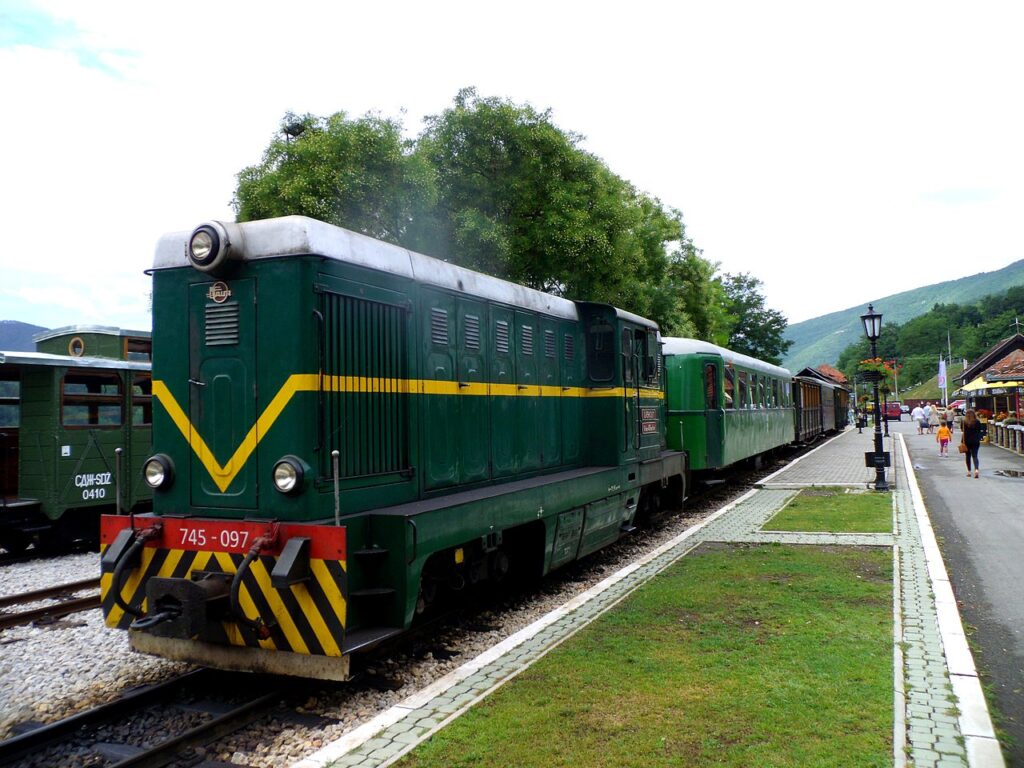
‘Šargan Eight’ Railway
With its charming wooden carriages and sensational views, this unique railway is a wonderful excursion and certainly not just one for rail buffs.
In a former life, the short stretch of convoluted track that is now called the ‘Šargan Eight’ used to just be one small section of the narrow-gauge line that connected Belgrade with the Bosnian capital, Sarajevo. The train was a lifeline for many communities that had previously been poorly connected and, until its closure in 1974, the Ćira train used to link the isolated villages in this part of western Serbia with the outside world.
The difficult, mountainous terrain of western Serbia ensured that it was a spectacular journey through steep cuttings and rocky gorges. Some sections were more problematic than others, however; in particular, the short section between Mokra Gora and Šargan-Vitasi. Although the horizontal distance between these two stations was a mere 3.5km, the height difference between them was a daunting 300m. Clearly, no ordinary train could cope with an incline this steep. The engineers came up with an ingenious solution to the problem and designed a loop in the shape of a number eight to connect the two stations. The loop – soon to be known as the Šargan Eight – was about 13.5km long and included 22 tunnels and ten bridges and viaducts along its length.
After 50 years of successful service, the Ćira line was declared to be unprofitable and the decision was made to close it down; the last train ran on 28 February 1974. Around 25 years passed by until fresh ideas of reopening the railway started to emerge, this time as a tourist route. During 1997 and 1998, villagers from around Mokra Gora organised voluntary work brigades to make the course of the railway passable once more. The route was finally cleared during the months of the NATO bombing in 1999, with the additional help of the Serbian army. Narrow 760mm-gauge track was laid along an 8km length of the line, a committee was formed to take charge of the railway’s revitalisation, and professional assistance of the Želnid Railway Museum was sought.
Two museum trains – Škoda and Elza – were overhauled and put into service, and authentic wooden passenger coaches were repaired and refurbished. Since its inauguration as a tourist line, the Šargan Eight has become a rare success story in troubled times. It has even captured the interest of film-maker, Emir Kusturica, who used the railway as the setting for his 2004 movie Život je čudo (Life is a Miracle) and built a film-set village on a hill above Mokra Gora.
The train leaves Mokra Gora station for Šargan-Vitasi three times a day, taking about 40 minutes to cover the short distance downhill. In winter, trains usually run to a different timetable and may only go as far as Jatare and back. It returns to Mokra Gora after a 20-minute break and takes an hour for the uphill return journey. A return ticket costs 900din for an adult, 450din for a child. The 13.30 departure is the one generally reserved for group excursions, so there is a slim chance that this one may be full if you have not pre-booked. A limited number of tickets are sold for standing-only passengers – if this is the case, try and get a place on the small platform at the rear of the train.
It is possible to hire the whole train for a bespoke trip, which costs between 75,000din and 135,000din, depending on the time of day or night and whether or not you wish to charter a steam engine.
Advance tickets can be reserved at the Šarganska osmica booking office or bought at Mokra Gora, Belgrade, Novi Sad or Niš railway station ticket offices.
Belgrade
The first thing anyone will tell you about Serbia’s capital is that it does not live up to its name – Belgrade, or Beograd (the ‘White City’), is anything but white. Rather, it is mostly a utilitarian grey, the colour of concrete, which looks its dreary worst under a leaden, winter sky and only marginally more cheerful in spring sunshine.
This stereotypical Eastern-bloc greyness is deceptive, however, because although the grim monoliths of New Belgrade’s high-rises do their best to dispirit the first-time visitor, the city has far more to offer than these initial impressions might suggest.
What to see and do in Belgrade
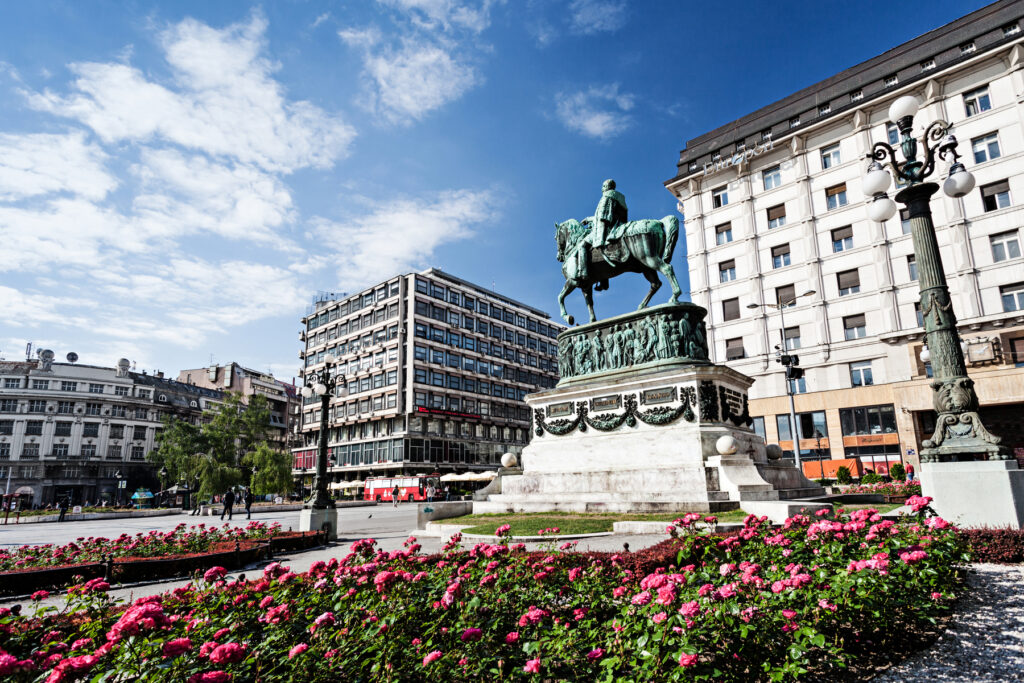
Old Town (Stari Grad)
Many of Belgrade’s most appealing landmarks lie within this comparatively small area. The Old City may be defined as being the part of the city that lies southwest of Dunavska, with its western boundary circumscribed by Karađorđeva and Kalemegdan Park, and its southern limit set by Brankova. This haystack-shaped concentration of Belgrade’s older buildings is bisected by Vase Čarapića (usually referred to as Vasina), an important artery that connects Trg Republike, the spiritual heart of the city, with Kalemegdan Park by way of Studentski trg.
The pedestrian thoroughfare of Knez Mihailova (sometimes called Kneza Mihaila) runs parallel to this. Trg Republike (Republic Square) is as good a place as any to begin. This large, elongated square has been renamed recently as Trg Slobode – Freedom Square – but most simply refer to it as ‘Trg’. Trg Slobode is flanked by the imposing Neoclassical edifice of Narodni Muzej – the National Museum – at its north side, with the National Theatre (originally built in 1869, bomb-damaged during World War I and rRebuilt with a new façade in 1922) just across Vase Čarapića to the east.
Kalemegdan Park gets its name from a combination of two Turkish words, kale (fortress) and meydan (town square). The name refers to the plateau itself rather than the fortifications that were built upon it that are simply known as the Belgrade Fortress. A good idea of the development of the fortress can be had by studying the models on display at the Belgrade Fortress Museum next door to the clock tower. This also clearly indicates how the small manmade harbour on the Danube below was created and defended, as well as how it subsequently vanished from sight.
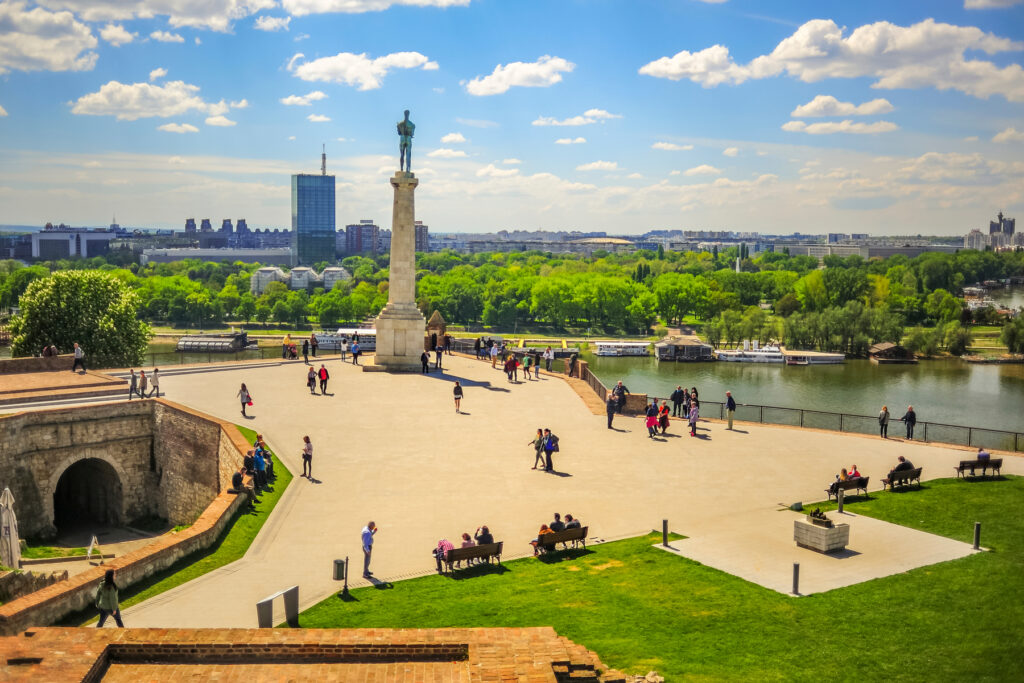
The Temple of St Sava (Hram svetog Save) is also within easy grasp from Trg Slavija – just a short walk south to the Vračar neighbourhood – and the church’s enormous dome can be seen from all over the city, gleaming through Belgrade’s haze in all directions like a beacon. Size apart, the church is undeniably a highly impressive structure: a neo-Byzantine colossus with echoes of St Sophia in Istanbul. The site at Vračar was chosen because it was the same place where the Ottoman ruler, Sinan Pasha, had the holy relics of St Sava burned in 1594, having seized them from Mileševa Monastery in Raška in southwest Serbia.
The mosaic in the main dome, costing around €4 million, was financed by the Russian Orthodox Church. Following the reconversion to a mosque of Istanbul’s Hagia Sofia in July 2020, it was hoped that St Sava’s would become a symbolic replacement for this iconic building.
The modern city
The sights of modern Belgrade are fewer and farther between than those of the Old Town, but they are interesting nevertheless, especially when considering the city’s more recent history. A short walk along Terazije from its junction with Knez Mihailova soon brings you to the imposing and attractive façade of the Hotel Moscow. This building, built in Art Nouveau style in 1906 for the ‘Russia’ insurance company, is one of Belgrade’s more notable landmarks, but the view across to the neon signs of Terazije and its dull row of traffic-grimed buildings is overall less pleasing.
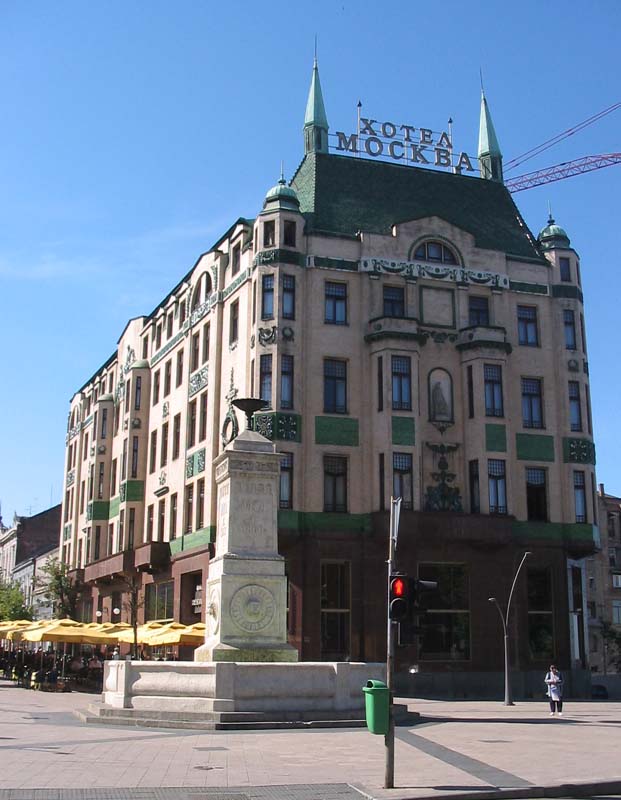
Sitting opposite the Hotel Moscow is the equally large but rather less grandiose Hotel Balkan. Walking down Prizrenska from here will soon bring you to Zeleni venac, an important terminus for the city’s bus network and the prized location of another McDonald’s branch. From the terrace above the bus park you can see the chequerboard-patterned roofs of Zeleni venac, condemned by some hard-line nationalists for echoing the Croatian national emblem in its design.
In the street behind, hidden away at Maršala Birjuzova 19, is the city’s only currently active synagogue, built in 1924–25 on a piece of land donated by the Belgrade Municipality. The gate leading into it appears to be locked nearly all of the time. Steps lead up from this rather woebegone street to Obilićev venac and a whole parade of trendy cafés.
Just off the street on the edge of Pionirski Park to the left, stands the City Hall, built in 1882 as the royal palace of the Obrenović dynasty in an Italian Renaissance style. The building now houses the mayor’s offices and is the premises of the Belgrade City Assembly; it was also used by Tito for a while in the early days of the post-war Yugoslav republic.
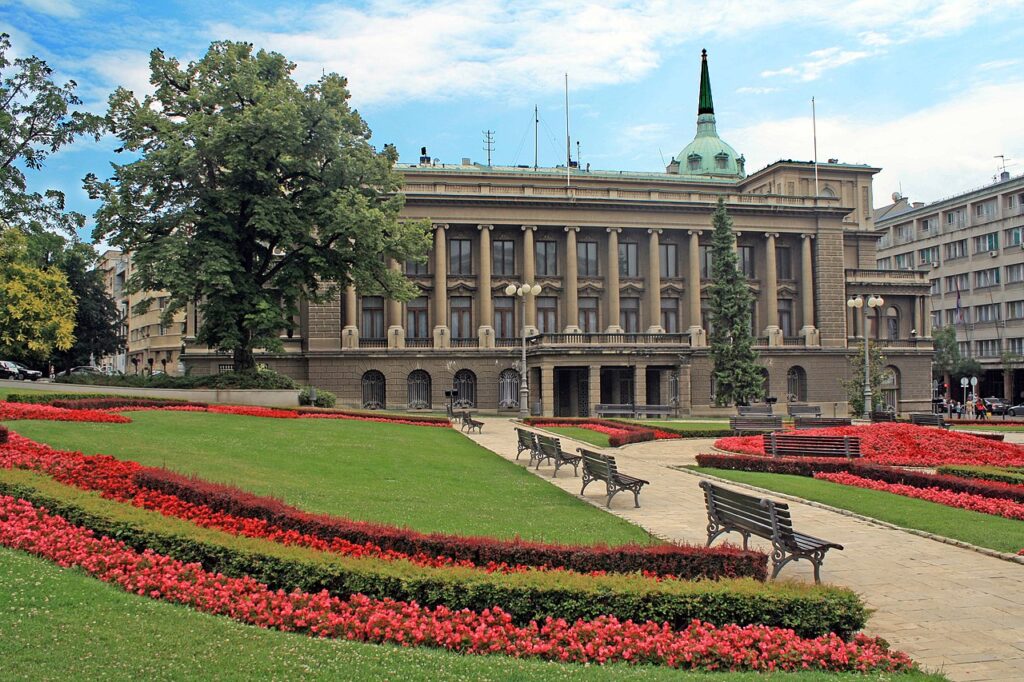
Next door to City Hall, across some gardens and a newly restored fountain, stands the New Palace, which was built between 1913 and 1918 for Petar I Karađorđević. This was restored after being badly damaged during World War I and reoccupied in 1922 when it became the official residence of the Serbian royal family until 1934 when King Aleksandar was assassinated. Today the building serves as the seat for the Serbian State Assembly.
Đavolja Varoš
Some 28km south of Kuršumlija, this strange and surreal collection of rocks constitute what is perhaps Serbia’s most intriguing natural landmark. Those who have seen Turkey’s Cappadocia region will have some idea as to what to expect, although the rocks here are smaller and cover a far less extensive geographical area than their Turkish counterparts. They are, nevertheless, highly impressive and well worth the effort it takes to reach them.
The rocks that make up ‘Devil’s Town’ are actually a tightly packed group of over 200 unusual stone formations created by the dual processes of weathering and erosion. Individual stone formations range from between 2m and 15m in height and each is capped by a flat stone of a different colour to create a spindly mushroom effect.
The geomorphological conditions that create formations such as these are extremely rare, hence the relatively small number of similar sites throughout the world. Put simply, they are the result of the action of very acidic water with high mineralisation on easily eroded soft rock that has a harder layer on top. Naturally enough, these unusual formations have given rise to various legends and folk myths that range from God petrifying guests at an incestuous wedding to the rocks being devils that have been turned to stone.
The protected 67ha site was developed and upgraded by the Serbian government in 2008 and now has a large car park, restaurants, public toilets and gift shops in addition to a raised walkway that leads around the site to provide a variety of viewpoints. There are also some interesting wooden sculptures to examine along the tourist route and other features such as medieval iron mining pits to contemplate.
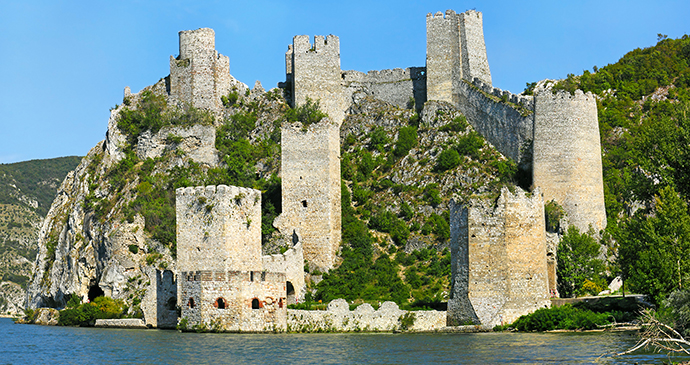
Golubac Fortress
Golubac Fortress lies 5km east of the Serbian town of Golubac, about a 50-minute journey along the main road from the village. It is possible to walk part of the way along a riverside pathway, but the main road is the only option for the rest, although there is a footpath along most of it.
The castle is clearly visible from the town itself but as soon as you start walking it disappears around a headland and only reappears once you are almost upon it. The walk is well worth the effort: Golubac is the perfect fairy-tale castle, wonderfully set off by its location in the rugged landscape at the head of the Đerdap Gorge and undoubtedly one of the most beautiful castles along the river’s length. It marks the beginning of the narrowing of the Danube at the Iron Gates and the western limit of Đerdap National Park; there is a noticeboard to this effect immediately before it. Golubac is also no longer a ruin, having been fully restored in recent years; some might even argue that it has been somewhat overdone.
The main road that used to pass through the fortress site now feeds through a tunnel behind the complex and there is a large car park, visitor centre with ticket office, souvenir shop and café. Separate tickets are sold for different zones of the fortress and do be aware that it closes early outside the summer months, although the green-zone archaeological area in front of the fortress is open later.
There are nine towers in all, each between 20m and 25m high. The castle’s ramparts climb high up the hillside above the main road and the extensive walls are impressively thick, with an average width of 2.8m. The various towers are ranked according to difficulty of access, with the Hat Tower considered the trickiest – it also requires a zone IV entrance ticket, the most expensive category, and a designated guide, as does Tower 7. It is suggested that zones II, III & IV require visitors to be in good physical condition and are not suitable for those who suffer from acrophobia (fear of heights) or ophidiophobia (fear of snakes), so with a bit of luck you might see some interesting wildlife along the way. Do take some time to explore the surrounding archaeological park as well, which holds the excavated remains of a Roman house, an Ottoman period hammam and a medieval lime kiln.
The fortress was built by Hungarians, who called it Galambocz, on the same site as the Roman Castrum Columbarum, probably sometime in the second half of the 13th century, although this is uncertain as the first written record that relates to it is from 1335. Golubac was captured by the Turks in 1391 and changed ownership several times before being finally reclaimed by the Serbs in 1867. On the Romanian side of the river lie the remains of another castle, Laslovar, although this is in a far more ruinous state.
Niš
With an estimated population of over 260,000, Niš is Serbia’s third-largest city. Authors of long-defunct guidebooks to the former Yugoslavia talk of a large ‘dull and dirty town’ and an air of ‘grey, grim abandonment’, but this is misleading as these days Niš is no longer an industrial wasteland but a lively university city with a handful of interesting sights. Its manufacturing pedigree has meant that it is not the prettiest of places but, then again, neither is Belgrade.
What to see and do in Niš
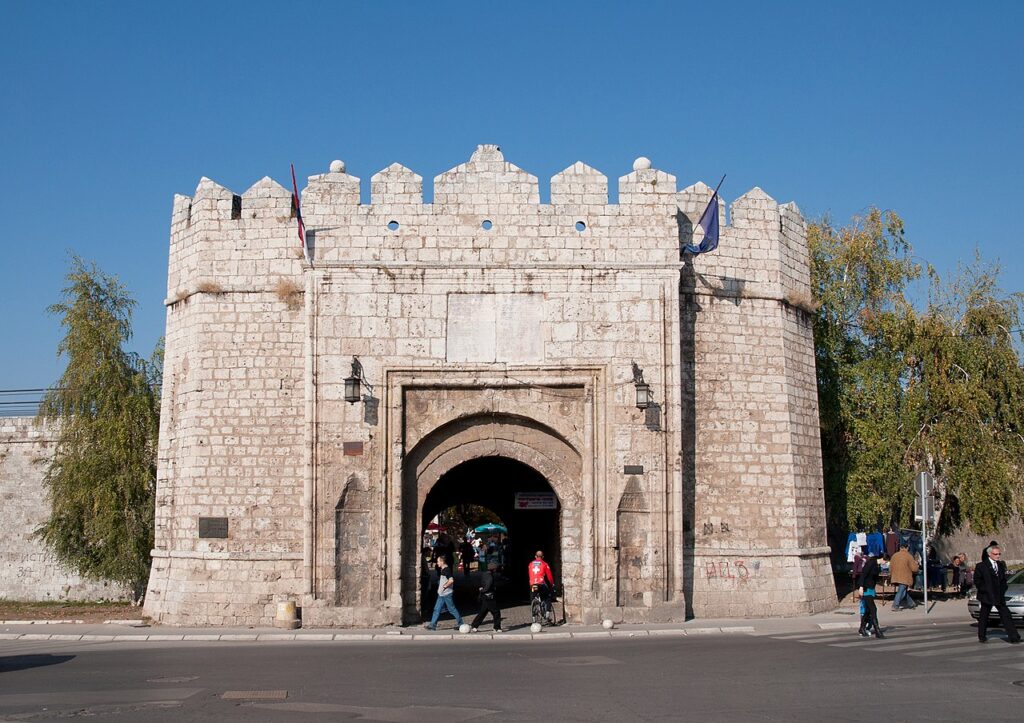
Niš Fortress
The fortifications that exist today date only as far back as the beginning of the 18th century, but the Turkish fortress on the north bank of the river that survives was built on the same site as earlier fortifications of Roman, Byzantine and medieval origin.
The fortress, which was constructed between 1719 and 1723, extends over an area of 22ha, with 2,100m of wall 8m high that has an average thickness of 3m. Outside the walls is a moat, the northern part of which still survives. Of the original gates, the southern Istanbul Gate (Stambol kapija) – the main entrance today – and the northern, Belgrade Gate (Beogradska kapija) are the best preserved.
The hammam by the Istanbul Gate, dates from the 15th century and is the oldest Turkish building in the city. Water would have been brought to the bath from the Nišava River by means of underground wooden pipes. Formerly a restaurant, the hammam now serves as a Jazz Museum dedicated to some of the artists who have performed at the Nišville Jazz Festival.
A little further on, standing alone at the centre of the fortress area, is the early 16th-century Mosque of Bali Beg, now an art gallery. A library once stood next to the mosque but only a ruin remains today. Close to Bali Beg’s mosque is the lapidarium, a small display of Roman gravestones and sculptures found within the fortress area and gathered together here. Beyond here to the north, along a path that leads off to the right, is the City Garden (Gradska bašta), a peaceful courtyard with flower beds and a pergola in the middle.
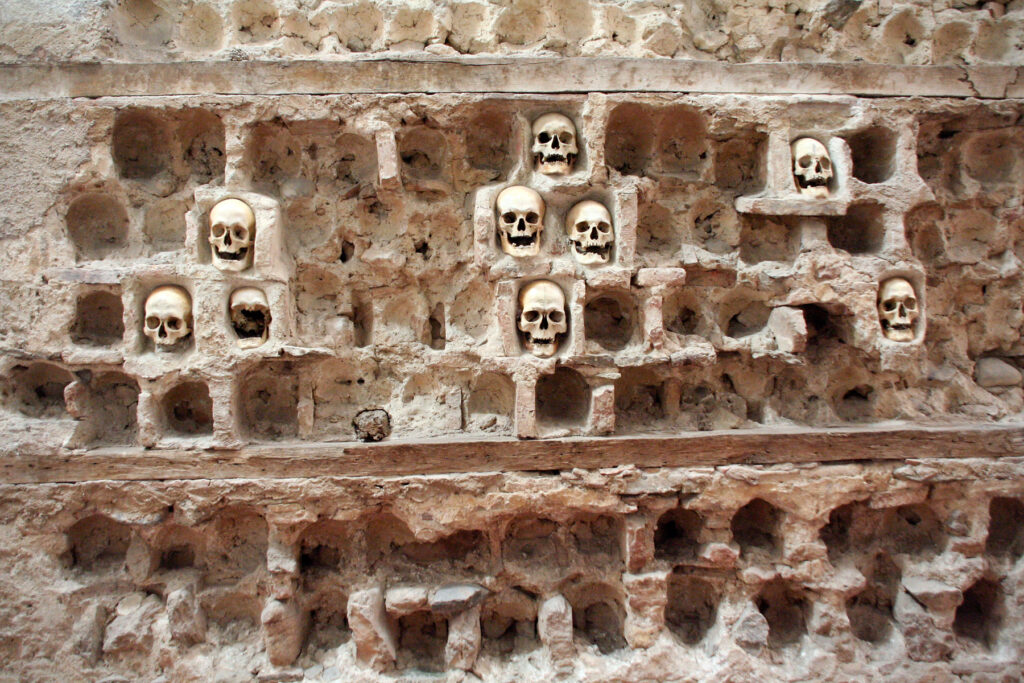
Skull Tower
This grotesque memorial was erected by the Turks as an example to others of the folly of opposition to their rule. Its construction followed the Battle of Čegar Hill in 1809 at the time of the First National Uprising when the Serbian General Stevan Sinđelić – ‘The Falcon of Čegar’ – fearing an ignominious defeat, famously blew up himself and his outnumbered troops, along with a large number of Turks, by igniting a gunpowder store. It is estimated that about 3,000 Serbian soldiers were killed in the explosion, along with at least double the number of their Turkish counterparts.
The tower was the Turkish response to this defiant yet suicidal act. On the order of the Turkish paša Huršid, the Turkish commander at the time, Serbian skulls were gathered from the battlefield and skinned before being mounted in rows on a specially built 3m-high tower. Originally there were 952 skulls embedded in the tower and past visitors to the monument have written of its eerie quality.
Pobeda
This is the main café-lined pedestrian street, otherwise known as Obrenovićeva, which runs from Trg Kralja Milana, with the tall edifice of the Hotel Ambasador and an equestrian statue dedicated to the Liberators of Niš, south past the Kalča Centre to Cara Dušana.
There are several wealthy merchants’ houses along its course, like that of Andon Andonović at number 41 built in 1930 in a neo-Renaissance style. At the bottom end in the small plaza at the western end of Kopitareva is an interesting and photogenic bronze sculpture that depicts two traditionally dressed Serbian men sitting at a table. Kopitareva, also sometimes referred to as Kazandžijsko sokače (‘Tinkers’ Alley’), dates back to the early part of the 18th century and was originally a street of tinkers and copper craftsmen.
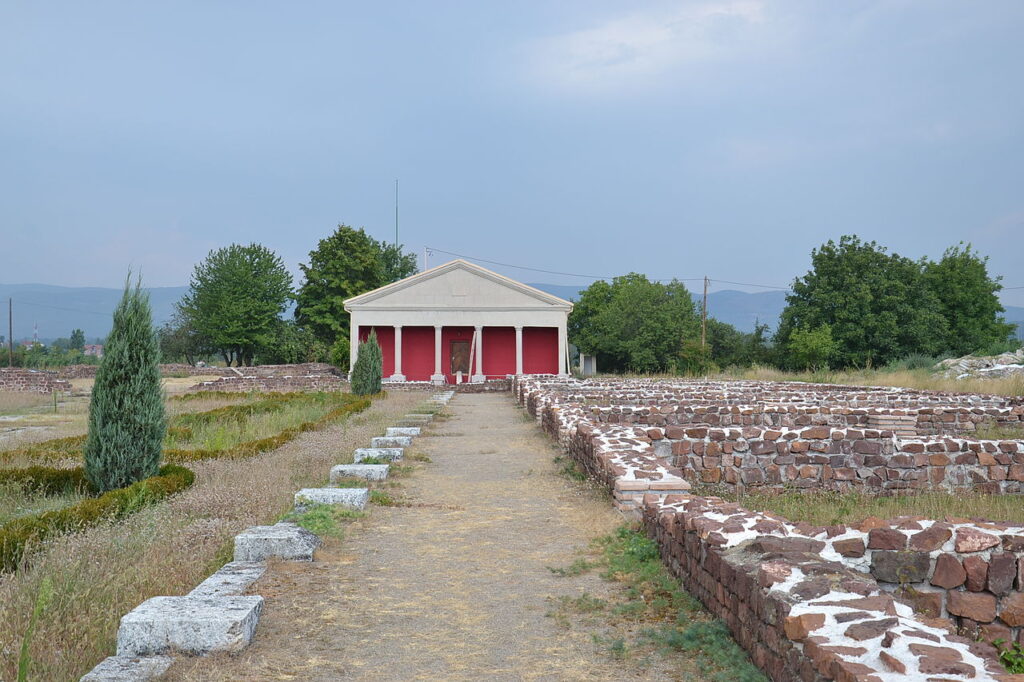
Mediana
Emperor Constantine the Great, who was born in Niš, is said to have returned a few times in his life. At Mediana, alongside modern-day Bulevar Cara Konstantina, the Niš–Niška Banja road, a luxurious villa was built at his command in the early 4th century. What remains today are the foundations of several buildings spread over an area of 40ha: a villa, a baptistry, baths, lesser villas and a granary. Much of the site has now been covered by a roof to protect the remains and mosaics from the elements.
There is evidence of a street that ran in an east–west direction, connecting the various buildings. The central area was taken up by the palace, nymphaeum and baths, while to the west was the granary and to the north, a building with octagonal and circular rooms. Domestic buildings lay to the south of the complex.
The museum has mosaics and an exhibition of various Roman artefacts found on the site. At the time of writing, both the site and museum were temporarily closed to the public, but they will hopefully reopen in the near future.
Logor Seven karst (Red Cross Camp) Museum
The camp was first built as an army depot in 1930 but was adopted by the Germans during World War II as a transit camp for Roma, Jews, Partisans and communists who were thrown in here prior to torture and/or execution or their deportation to death camps.
It is a grey, sombre place that seems full of ghosts, as well it might. Despite hopeless odds, a desperate escape bid was made on 12 February 1942 when an attempted breakout was made by scaling the walls. At least 50 prisoners were machine-gunned down immediately, while another 100 managed to escape to freedom.
The main building on the right shows the conditions under which the prisoners had to live – on concrete floors with straw for bedding. The solitary confinement cells in the attic are perhaps the most chilling. On the walls are numerous photos of the inmates taken in happier times, their smiling, handsome faces blissfully unaware of the fate that was to befall them, making them all the more poignant. Another photograph shows the leering face of the camp commander, Kommandant Schulz, nicknamed ‘Stick’ because of his taste for beating inmates to death with his cudgel. All the captioning is in Cyrillic but this hardly detracts from the sheer existential horror of the place.
There is also a room that has paintings done by children from a local school, which graphically depict the scenes of horror in the camp – attempts on the wire, beatings, rapes, torture – in the earnest, unflinching manner of children whose imagination has been painfully awakened.
Novi Pazar
Sitting among low hills where the Raška has its confluence with the Ljudska, is the large town of Novi Pazar (New Bazaar), capital of the region. Almost immediately upon arrival you notice how different it seems from similar-sized towns to the north like Kraljevo or Čačak.
Other than in Kosovo, Novi Pazar is the town with the most pronounced Islamic atmosphere in the country: instead of church domes, it is minarets that stab the skyline, and rather than the relaxed and carefree mixing of the sexes that takes place throughout most of Serbia, men and women seem to live more separate existences here.
Almost everywhere you look there are coffee houses full of huddled groups of men drinking small glasses of čaj or Turska kafa, talking and playing backgammon in a haze of cigarette fog. Even without the existence of mosques and old Ottoman buildings, such characteristics give evidence that this is still very much a Turkish town and, despite the worst excesses of 1970s Yugoslav town planning, modernisation has failed to destroy the distinctly Muslim character of Novi Pazar.
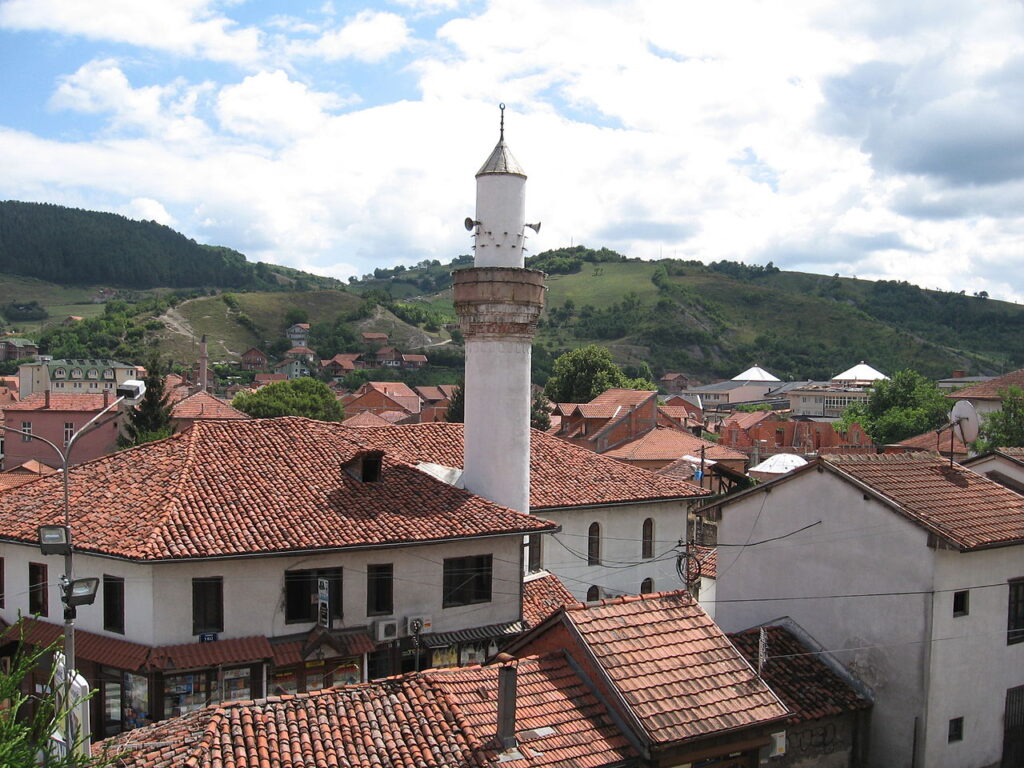
What to see and do in Novi Pazar
Part of the pleasure of being in Novi Pazar is to simply absorb its vaguely exotic atmosphere. The evocative sound of the muezzin – the call for prayer five times a day – that emanates from the mosques is a reminder that Turkey and the Middle East are not so very far away. The smells are redolent of the East too, with the ever-present, sweet-and-sour aroma of roasting coffee beans and grilling ćevapčići managing to overpower the stench of exhaust fumes even in the heart of the town centre.
The old Turkish quarterlies east over the bridge from here beyond the Turkish Fort (Tvrđava) that looks down over the central square, the grubby river and the dubious architecture of the Hotel Vrbak. The fortress, which dates from the 15th century, was formerly the seat of the Turkish sanjak in the region, and is home to a pleasant park these days. It was originally built to a triangular plan probably on the order of Isa-beg Išaković, the town’s founder. New buildings and reinforcements were added later, between the end of the 17th century and the middle of the 19th. Some of the original ramparts remain, together with an octagonal watchtower, but otherwise there is little to see.
Heading south over the bridge from the square, a narrow cobbled road, 1 Maj, leads through the old bazaar area to the early 16th-century mosque of Altum Alem, the most important Turkish building in the town. Access to the mosque can be gained through the courtyard at number 79, which houses several Ottoman-period graves and the entrance to an Islamic school. Altum Alem, built by the master builder Abdul Gani, is of a square plan, with a dome and a spacious porch covered with cupolas that are not typical for the region. There is a wooden gallery and a colourful mihrab within.
The road that leads to the mosque is lined with small restaurants that specialise in ćevapčići; coffee houses, butchers’ shops and small bakeries selling burek; closer to the bridge is a small enclave of shops that specialise in gold jewellery. Close to the bridge is a ruined hammam that probably dates from the 1460s and which was endowed to the town by its founder Isa-beg Išaković. It is a symmetrical structure with facilities for simultaneous bathing by men and women.
On the north side of Žitni trg is an old Ottoman Han (inn) dating from the 17th century, part of which currently serves as a restaurant and a guesthouse. This comprises a group of four buildings facing on to a common courtyard. In the past, the upper floor would have been reserved for the accommodation of passing traders (it still is), while other parts would have housed the cattle and animal stock that the visitors brought with them.
In contrast to this, on the opposite side of the square, is the Hotel Vrbak, one of the most unusual hotels in the country. It is hardly beautiful but the Hotel Vrbak cannot fail to impress with its mad-cap modernism, and gives weight to the theory that however much communist-period architects were under instruction to produce cheap, utilitarian housing for the proletariat, they were given completely free rein when it came to the design of hotels; that is, as long as they stuck to a vaguely futuristic concept.
The Vrbak is a prime example of this: a wacky architectural conceit that was taken seriously by a planning committee and immortalised in concrete – a curious combination of retro-Ottoman and modernism. The building consists of two hexagons joined together on two sides, with an extension reaching south across the lacklustre river channel that passes unglamorously through the town.
Novi Sad
Capital of Vojvodina and, with a population of more than a quarter of a million, Serbia’s second-largest city, Novi Sad is a relatively prosperous, commercial, industrial and university town on the north shore of the Danube in the Bačka region of the province. Long referred to as the ‘Serbian Athens’, Novi Sad has always been a centre of culture and learning and the atmosphere of its small but elegant city centre seems somehow a little more refined than that of the capital.
What to see and do in Novi Sad
Most of the city’s sights are within a small area of the centre. The hub is spacious Trg Slobode, with the neo-Gothic brick-clad Roman Catholic cathedral on one side of the square and the City Hall facing it on the other. In the centre of the square stands a statue of Svetozar Miletić (1826–1901), one of the most prominent Serbian politicians of the 19th century – a 1939 creation of the seemingly ubiquitous Ivan Meštrović.
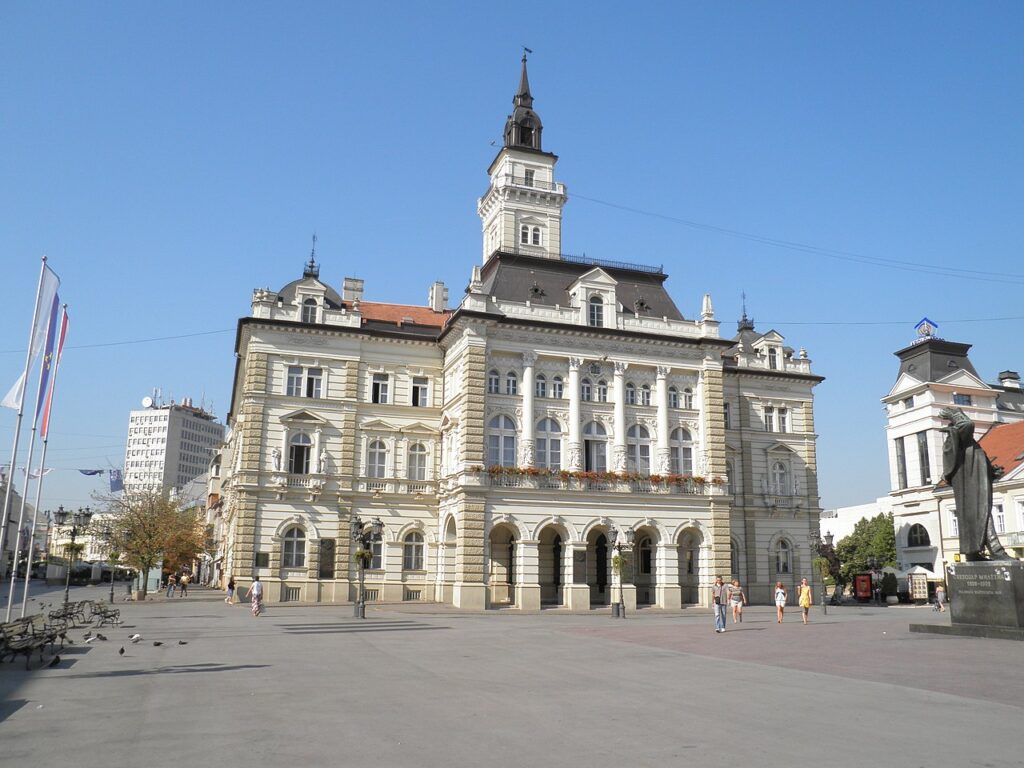
The figure, in a strident, almost ranting, pose faces towards the cathedral, his back turned on the elegant City Hall (Gradska kuća): the neo-Renaissance, two-storey building that is a copy of the town hall in Graz, Austria. The Roman Catholic cathedral (Katedrala – Župna crkva Imena Marijina) opposite was built between 1893 and 1895, at the same time as the City Hall, on the site of a former 18th-century church. The building, with three naves and a 76m-high tower, is not a cathedral at all – the seat of Bačka’s bishopric is actually further north in Subotica – but rather, a parish church dedicated to Mary. Over the years it has been its impressive size, rather than its ecclesiastical status, that has caused it to be known as the ‘cathedral’. The interior is richly carved, with four altars and 20 windows designed by Czech and Hungarian stained-glass craftsmen. The roof has a steep pitch and is strikingly patterned with multi- coloured Zsolnay tiles.
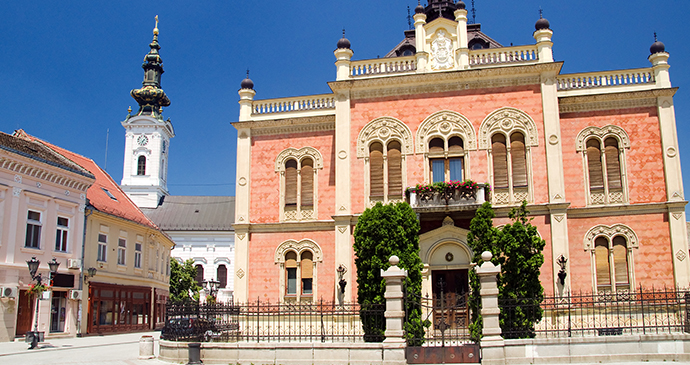
The Bačka Bishop’s Palace (Vladičanski dvor) is the residential palace of the Serbian Orthodox bishop in Novi Sad. It was constructed in 1901 on the site of a former palace that dated from 1741. The building style is curiously eclectic: a mix of secessionist and Serbian Romanticism, with pseudo-Moorish plasterwork decoration on red brick. In front of the palace stands a statue of Jovan Jovanović ‘Zmaj’ (1833–1904), the city’s famous doctor and children’s poet.
The Orthodox Cathedral Church of St George (Saborna crkva Svetog Georgija) lies just behind the palace. The present church was erected on the same site as an older one from 1734, which was burnt out, like so much else, by the Hungarian shelling of the city in 1848 and 1849. The restoration took place between 1860 and 1880, with a second phase of work from 1902 to 1905, when the bell tower was erected. Inside, there is a total of 33 icons on the iconostasis and two larger icons by the famous painter Paja Jovanović who also designed the stained-glass windows.
Leading off from here is the pedestrian street of Dunavska, one of the city’s most attractive thoroughfares with many 18th- and 19th-century buildings. The City Library (1895) is on the corner with Gimnazijska and further down, close to the junction with Ignjata Pavlasa, is the Museum of Foreign Art (Galerija – Zbirka Strane Umetnosti) at number 29. Beyond here, the street runs along the edge of a pleasant park with a small lake – Dunavska Park – a leafy escape from the city bustle. The park’s fountain has a sculpture The Nymph as its centrepiece, the 1912 work of Đorđe Jovanović, a prominent Serbian sculptor of the period.
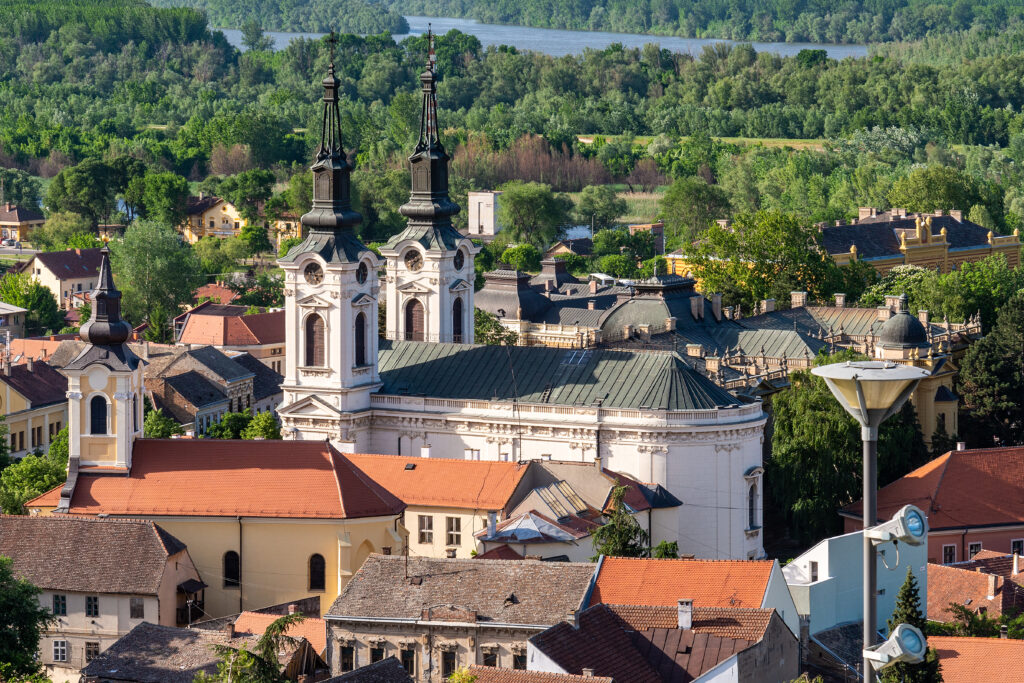
The small St Nicholas Church (Nikolajevska crkva) is the oldest Orthodox church in Novi Sad, mentioned in official records from 1739 as the endowment of the Bogadanović family, wealthy merchants in the city at that time. The church served as both a Serbian and a Greek Orthodox place of worship for many years. It was damaged in the 1849 bombardment of the city, and again in 1862, after which it was renovated at the expense of benefactors Jovan and Marija Trandafil. The church, unusually, has a small gold-plated onion dome in the style of a Russian Orthodox church.
The Gallery of Matica Srpska was founded by Matica Srpska in Budapest in 1826 and opened to the public in 1847. In 1864, the gallery was transferred to Novi Sad and it was placed in its current building in 1958. The gallery, one of the best collections of paintings in the country, represents Serbian artists working in Vojvodina from the 17th to the 20th century. The collection is spread throughout 19 rooms and laid out in chronological order.
The ground floor is given over to copies of frescoes taken from various Fruška Gora monasteries. The works on the first floor are mostly 18th century and are largely of a religious nature and by unknown artists. In the rooms representing the 19th century, the works of Pavle Simić (1818–76) and Đura Jaksić (1832–78) feature heavily but there are also some fine, very human portraits by Pavel Burković (1772–1830) and by Nikola Aleksić (1811–73), whose women all seem to wear a provocative expression that lies somewhere between conspiratorial and sexually precocious.
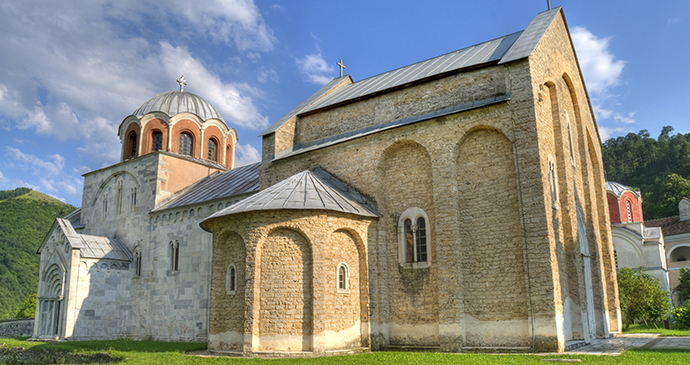
Studenica Monastery
Deliberately remote, the Monastery of Studenica sits in splendidly mountainous surroundings, high above the river that bears the same name, and even higher above the Raška Valley, a dozen kilometres to the east. Originally established by Stefan Nemanja at the end of the 12th century, this is undoubtedly one of the country’s greatest monasteries and one of the holiest places in the Serbian national psyche.
The monastery consists of three churches within an oval walled complex (originally there were nine). The largest of these, and central to the complex, is that of the Church of Our Lady (Bogorodičina crkva), completed in 1196. The exterior is of polished marble, unique in Serbian medieval architecture, with elaborately sculptured leaves, figures and mythological beasts in the Romanesque style decorating the windows and doorways. Inside, the effect of smooth marble is marred by a clumsily executed exonarthex, added by Radoslav, one of the later rulers of the Nemanjić dynasty, who added this maladroit extension around 1230.
The marble tomb of Stefan Nemanja is situated in a chapel to the right of the exonarthex beneath a fresco that shows him holding a model of the church and being presented to Christ and the Virgin. It was at Studenica that Stefan Nemanja abdicated before his retirement to Mt Athos in Greece. His body was returned here after his death.
Most of the original frescoes, completed in 1209, and probably the work of a single artist, were repainted in 1569. They are divided into an upper part that has a gilded background, a middle part with a yellow background and a lower part, with a blue background. The work reflects a development in the Serbian tradition in which there is an increased emphasis on the human form, its physical strength and its definition of character. Exceptions to the 16th-century repainting are part of the Annunciation and the Crucifixion, which adorns the west wall and shows the figure of Christ flanked by St John and the Virgin.
Next door, and tiny in comparison, is the King’s Church (Kraljeva Crkva), built by King Milutin in 1314. The frescoes here are very well preserved and represent some of the greatest religious art in the country, painted in the period when Serbian fresco art was at its peak. The north wall has the fresco of the Birth of the Virgin, which shows how Serbian artists had gone beyond mere symbolism by this date to become increasingly interested in portraying realism and technique. To the left of the Virgin child, a woman holds a tray of surgical instruments while the figure of Destiny fans the newborn; in the foreground, a woman is portrayed testing the temperature of the water with the back of her hand.
The third remaining church is the early 13th-century Church of St Nicholas (Sveti Nikola), which has a few surviving frescoes of interest and a 17th-century iconostasis. It should not be forgotten that Studenica is no mere museum but a thriving, working community that, while welcoming visitors, is not in the least dependent on them for its existence. For the monks here, the monastery is both a religious retreat and a workplace where spiritual contemplation is mixed with more mundane tasks like chopping wood and growing vegetables. Visitors are steady and frequent but rarely overwhelm the tranquillity of the place. Rather than just visit as a day trip, it is also possible to stay for longer and absorb the peaceful atmosphere here.
Subotica
If you travel from Hungary, and particularly from Szeged, with its colourful secessionist buildings, Subotica does not come as too much of a surprise; if anything it seems more of a continuation of that which has gone before. The border does not seem to count for much here and you do not suddenly plunge into a Serbia that is culturally at odds with anything you have seen further north.
Subotica, the second most populous centre in Vojvodina after Novi Sad, and the administrative centre of the North Bačka district, is Serbia’s most Hungarian town by a long chalk. Signs on the street are dual-language, and many local newspapers, radio stations and television channels use the Hungarian language rather than Serbian.
For the visitor, the novelty of all this depends on which direction they are heading. Travelling from the south, it can come as a pleasurable jolt that Serbia suddenly seems a long way distant; that Turkish influences are nowhere to be seen, and that the hegemony of the Orthodox Church has suddenly faded away. Coming from the north, it may just seem like more of the same. Either way, the gaudy elegance of middle European secessionist architecture is a dominant feature of the townscape. Love it or hate it, it is the architecture of the town that is Subotica’s greatest draw.
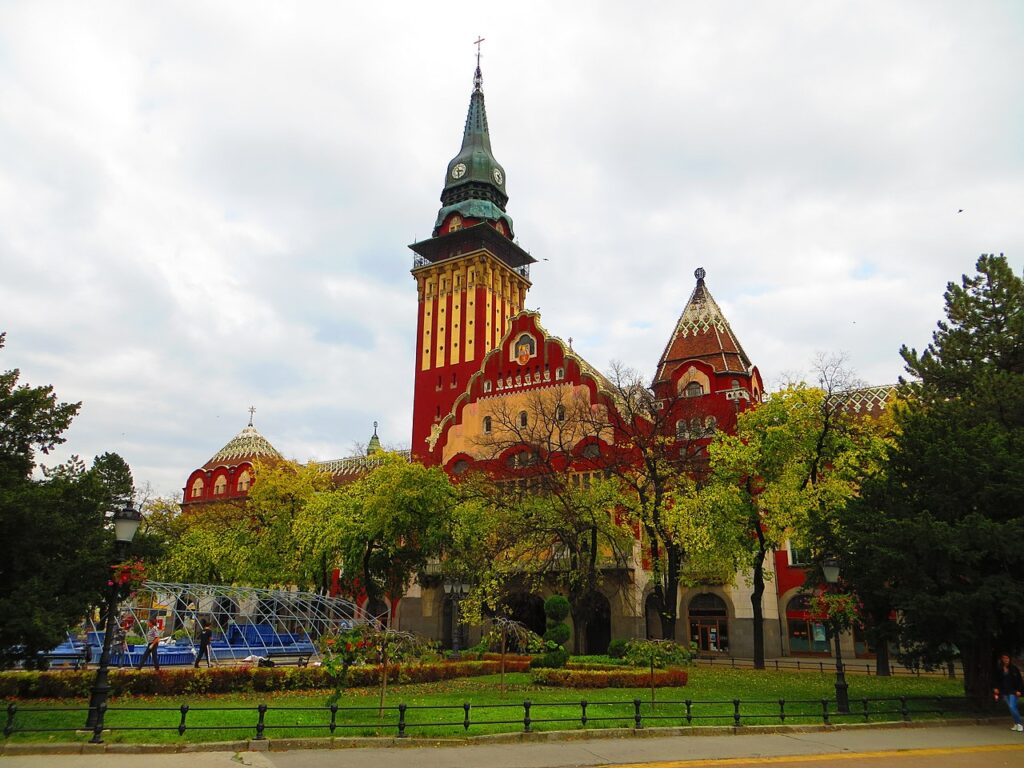
What to see and do in Subotica
The Art Nouveau town hall (Gradska kuća), built in 1908–10, is easily the town’s most impressive building even if it is not to everybody’s taste. With fancy gables and towers, patterned brickwork and gaudy colours, it is an architectural mishmash of styles that could be said to verge on the tasteless. The rhythm of its design might be described as heavily syncopated – frenetic even – but what it lacks in harmony it makes up for with sheer cheerfulness. As well as the town’s administrative offices, the building houses several banks, restaurants, gift shops and the municipal museum.
It is possible to take a tour up to the town hall’s 45m clock tower. Departures are at noon from Tuesday to Friday. You are supposed to have a minimum group of five persons but they seem to be quite flexible about this. There is a small entrance charge to the watchtower. It is a steep climb but from the top you are rewarded with a marvellous view over the town and surrounding countryside. Telescopes are provided for a closer look at the world below.
Facing the town hall is the National Theatre which originally dates from 1854, making it one of the oldest theatres in the country. Because of serious structural damage two-thirds of the original Neoclassical building was demolished in 2007 to allow a reconstruction to be erected on the site.
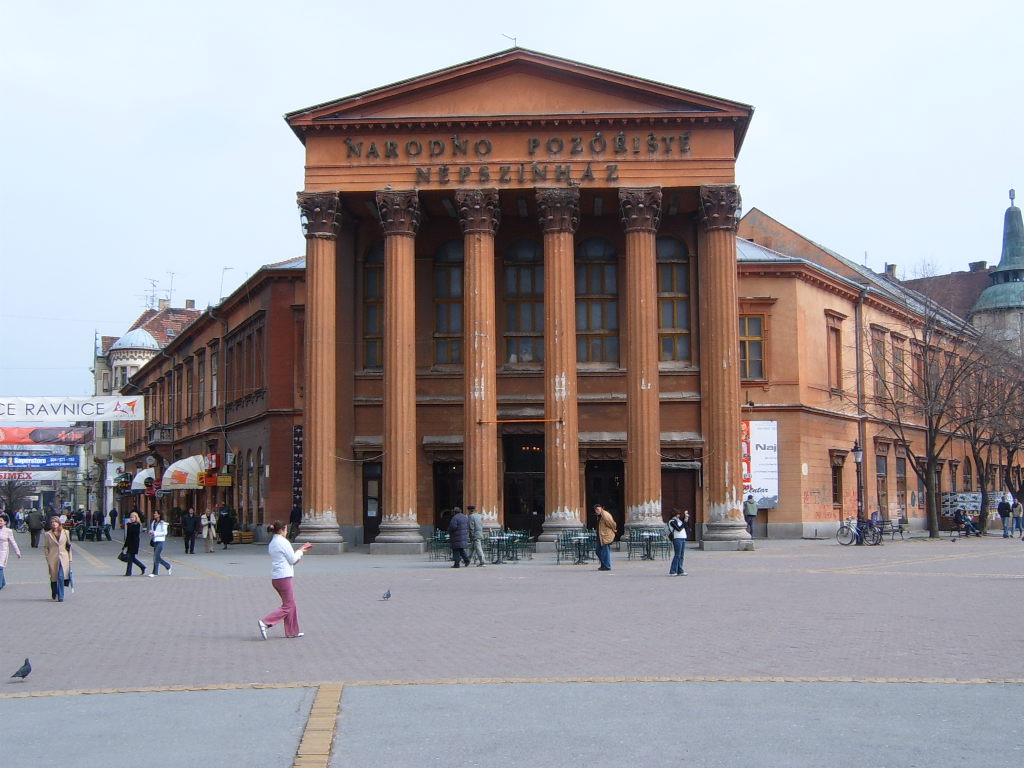
The rest of this central zone is contemporary with the town hall and several other examples of the Art Nouveau/secessionist style can be seen along the pedestrian street of Korzo, such as the building that now houses the Continental Bank building, which has heart shapes around the windows and painted shutters on the upper floor.
There are more secessionist buildings nearby at the northern end of Dimitrija Tucovića but the most important remaining edifice in this style is the imposing synagogue that stands alone close to the town’s market area. The synagogue (1902), on the south side of Trg Jakaba i Komora, was one of the first Art Nouveau buildings to be constructed in Subotica, designed by Dezsó Jakab and Marcell Komor who were responsible for several other buildings in the town including the town hall.
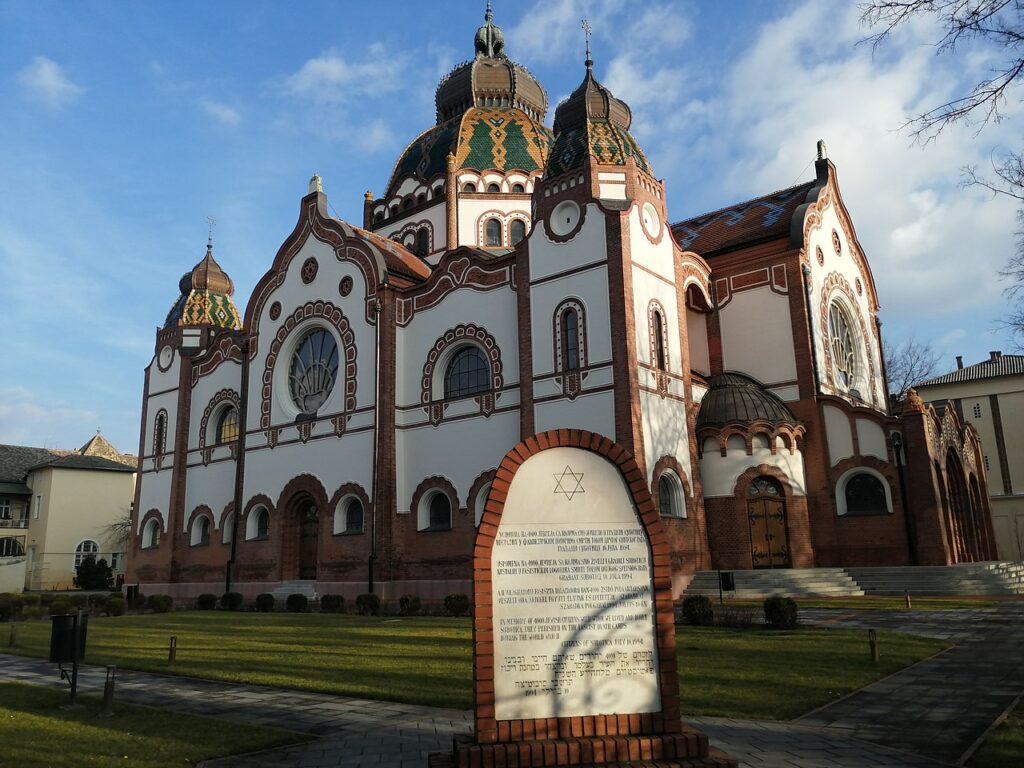
The architects have recently been honoured in the renaming of the square, which is now known as Trg Jakaba i Komora. The temple has a large green hexagonal dome, with curved gables and large rose windows that are crowned by smaller ones with Star of David brickwork. Now that virtually all of Subotica’s Jewish community have gone – either killed during World War II or as migrants to Israel – the building is rarely used and it is starting to look run-down.
The town’s Municipal Museum is housed in a building on the same street as the synagogue. As well as a large pottery section it has a large ethnographic and archaeological collection from the Subotica region, with plenty of local costumes and musical instruments as well as oddments like bee-keeping equipment and an enormous 1831 wine press. All captions are in three languages: Hungarian, Cyrillic Serbian and Croatian.
Vršac
The medium-sized Serbian town of Vršac lies out on a limb in the southeast Banat and is not a place you would pass through unless you were heading for Timişoara in Romania. This is a pity as it has a fair amount to offer and is worth considering as an excursion in its own right. Although there are adequate places to stay, it is possible to visit the town as a lengthy day trip from Belgrade.
What to see and do in Vršac
While there are a few specific sights well worth seeking out, much of the charm of the town lies in its domestic architecture as, unusual for Serbia, there are whole streets that have changed little in 200 years. One such street is Jaše Tomića, which runs east–west across Dvorska, the high street at the bottom end of Trg Svetog Teodora Vršačkog. There is an impressive row of period houses in the Vojvodina style running along here, in particular numbers 30/30a next to Dom Omladine, and the bright yellow residence a little further along that is dated 1608.
Dvorska is also the location for the Palace of the Bishop of Banat (Vladičanski dvor), a large yellow Baroque building with a shiny green-glazed tiled roof that dates originally from 1759 but which was later rebuilt. On the other side of the street is the Orthodox Cathedral of St Nicholas (Saborna crkva Svetog Nikole), built 1783–85, with paintings by Paja Jovanović and an iconostasis that was originally painted by Pavle Đurković but which has since had most of its panels clumsily restored.
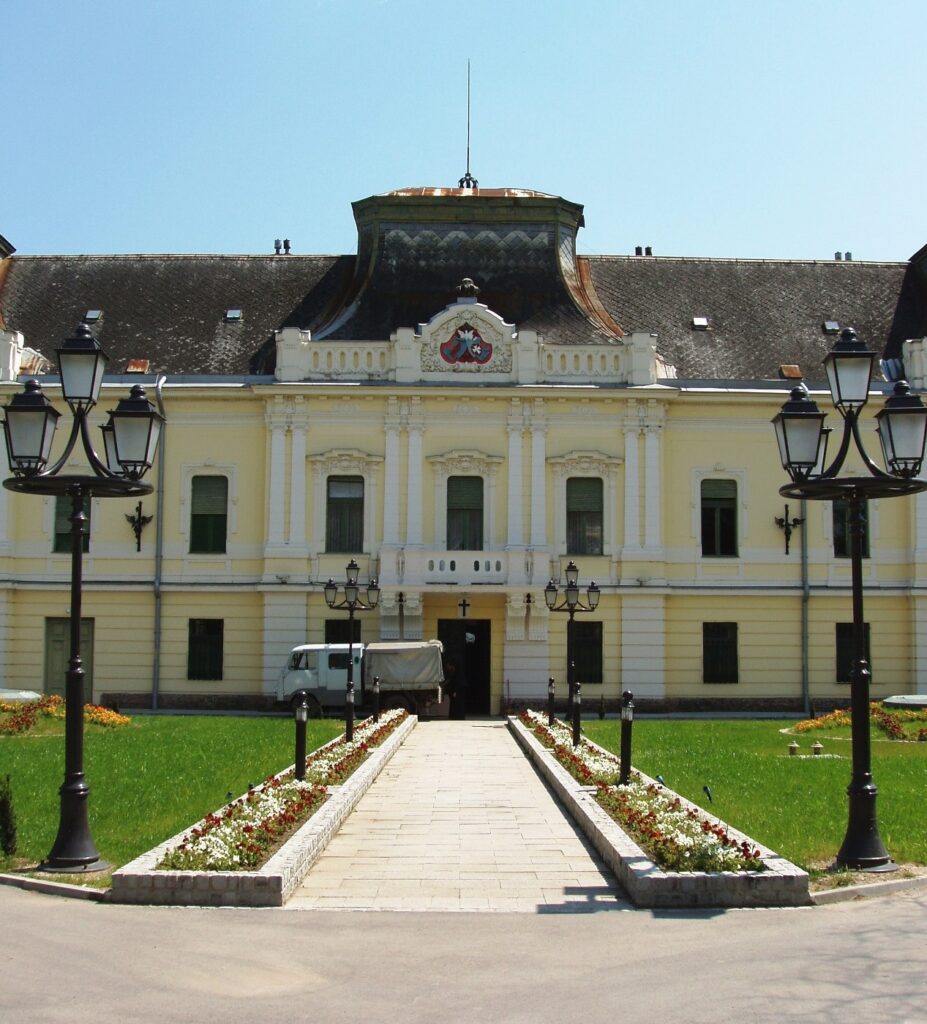
Nearby, just to the north of Trg Pobede and on the corner of Kumanovska and Stevana Nemanje, is the Pharmacy on the Steps Museum, with the entrance on steps above the street, as the name implies. This was the town’s first pharmacy, opened in 1784 and operational until 1965 when it became a museum. There are two exhibitions on display here: one concerning medicine and another dedicated to the work of the artist Paja Jovanović, whose brother worked here. Visits may be pre-booked by phone or prearranged at the town museum. Just around the corner, where Dositejeva meets Stevana Nemanje, is a rather curious Romanian neo-Gothic church with red and yellow brickwork, a cupola and a tower inlaid with the ceramic images of saints.
Clearly visible from anywhere in town is Kula breg, a 15th-century defensive tower that surveys the plains from its 400m vantage point on a round volcanic hill immediately above Vršac. Although close scrutiny does not reveal very much more about the site, it is as good a destination as any for a walk outside the town. apela breg, also known as the Chapel of the Holy Cross, is the oldest church in Vršac, constructed between 1720 and 1728. In 1739, it became dedicated to St Rok, the protector from plague (there was an outbreak of plague in the town during that same year).
Just above here is the main road and, on the other side of it, a meadow with a noticeboard, picnic tables and small amphitheatre. The larger Church of St Teodor (Crkva Svetog Teodora Vršačkog), also visible from the town, is just off the road to the left down a track. There is a car park area to the left of the road and a rustic café-restaurant with a garden next to it.
Related books
For more information, see our guide to Serbia:
Related articles
There’s not a hot cross bun in sight!
Love it or hate it, Subotica’s architecture is this Serbian town’s greatest draw.
The hills of Fruška Gora in Vojvodina are dotted with architectural masterpieces.
From stunning landscapes to sites of historical and cultural importance, monasteries provide a wealth of interest for the avid traveller.
There are many national parks in Europe that remain fairly unknown. Here you can discover 14 of the best. Why miss out on visiting somewhere spectacular?
Serbia has a rich and varied fauna, with nearly 80% of European bird species being recorded in the country as either breeding or on migration.
